- Growing Houseplants
- Indoor Garden Ideas
- Cactus & Succulents
- Houseplants Care
- Flowers & Blooms
- Gardening Guide
- Plant Care and Tips
- Beans/Fruit Vegetables
- Companion Planting
- Culinary Herbs
- Flowering Herbs
- Garden Design
- Gardening Ideas
- Growing food
- Growing Trees and Shrubs
- Leafy Vegetables
- Medicinal Herbs
- Patio Gardening
- Root Vegetables
- Shade Plants
- Temperate Fruits
- Tropical Fruits
- Balcony Gardening
- Container Fruits
- Container Gardening Ideas
- Container Herbs
- Container Vegetables
- Rooftop/Terrace Gardening
- Urban Gardening
- Vertical Gardening
- More Than Gardening
- Best and Top of Gardening

- Container Gardening
- Indoor Gardening

Wandering Jew Care | How to Grow an Inch Plant Indoors

2-Minute Read
If you are looking for the best tips on wandering jew care , then you are at the right place learn everything in detail including the propagation..
Wandering Jew is a popular indoor/outdoor plant with purple leaves, stems, and blooms. The name comes from the plants’ trailing nature! Here’s all you need to know about the right Wandering Jew Care.
Here are the best types of Wandering Jew plants you can grow
Propagating wandering jew.
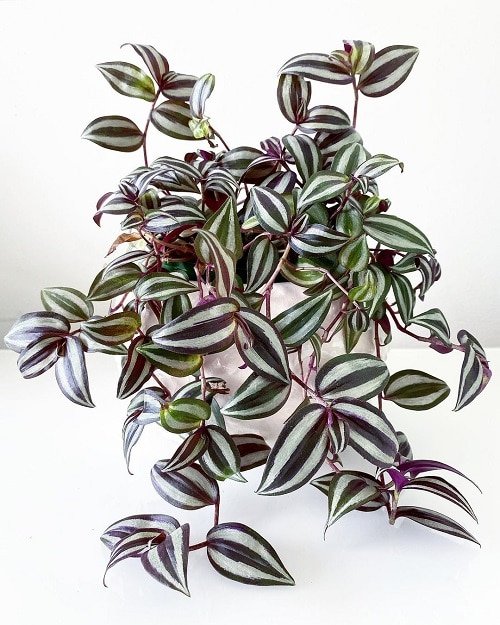
Propagation can be done at any time of the year by pinching off a 3-4 inches long stem and putting the cut end in a glass of water or soil. Place the cutting in a warm, bright location away from direct sunlight. Change the water every 3-4 days. If you are growing it in soil, keep the soil moist. Avoid overwatering,
In 7-10 days, you will see new roots developing on the cut end of the stem. Wait 1-2 weeks to allow a strong root system to develop then plant it in a container filled with potting soil . The new plant can be planted directly into outdoor soil in spring or summer!
Check out our article on propagating wandering jew in water here
Best types of wandering jews.

- Tradescantia sillamontana: The plant stays compact and looks great with green foliage covered in a fine layer of hair.
- Tradescantia spathacea: Also popular as Moses-in-a-basket, it is a beautiful tabletop plant with spiral-shaped dark green leaves.
- Tradescantia longipes: This plant looks awesome in gardens with its three-petaled blue flowers.
- Tradescantia fluminensis: You can grow it both indoors and outdoors with ease. It grows stunning triangular white flowers.
Wandering Jew Care
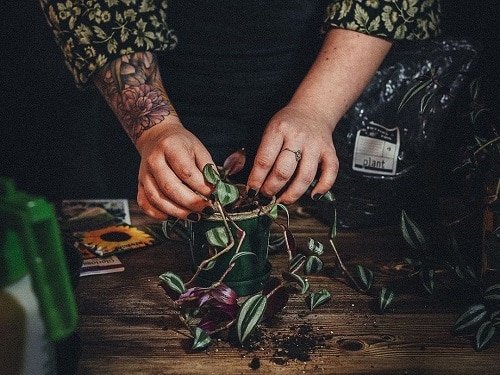
Wandering Jew will be at its deepest shade of purple when it is located in an area with bright indirect sunlight. It will grow well in a sunny location (outdoors or indoors) if it has some shade during the day. Just keep it safe from the harsh afternoon sun exposure.
This hardy plant is not too picky about the soil conditions, but it does not like soggy soil or hard clay. Use standard potting soil when growing in a container and add compost when planting it outdoors.
It grows best when the soil is kept consistently moist. The best part is, the plant can also tolerate drought as well! However, avoid overwatering and keep an eye on the topsoil for moisture.
If it is being grown indoors as a houseplant, mist the plant during the winter and water the soil sparingly. The dry air indoors caused by heat will quickly dry the plant and misting it every few days will keep it hydrated and thriving.
Fertilizing
Use an all-purpose, half strength, water-soluble fertilizer, once a month, during the growing period. Once the plant attains good growth, it will thrive happily without feeding.
Prune the plant occasionally to encourage its growth. Pinch back some of the long, vining tendrils from time to time. You can also snip some of the stems to give the plant a uniform shape.
If you want to make the plant look fuller, cut the stems and put them in the soil of the same pot. It will make the plant multiply – making it look bushier.
Recent Posts
Grow big, bushy, and lush hostas with epsom salt: 4 best uses, how to grow a spilling jade plant, 21 best chocolate flowers, 24 best fruits that start with i, how to grow cherry blossoms in a pot, 14 unique and unusual perennials you can grow this summer, 11 most beautiful flowers for guys, how to keep a peace lily alive and thriving for years to come, join our 3 million followers:, related articles, 18 plants to grow under tomatoes | what to plant with tomatoes, 16 annuals that grow vertically, 17 trees that look like a fern, 20 best plants for hanging from the ceiling, leave a reply cancel reply.
Save my name, email, and website in this browser for the next time I comment.

Get the Best of BalconyGardenWeb Directly in your inbox.
POPULAR CATEGORY
- Best and Top of Gardening 1583
- Flowers & Blooms 634
- Growing Houseplants 599
- Gardening Guide 412
- Gardening Ideas 381
© 2023 Balcony Garden Web | All rights reserved
- Privacy Policy
- Terms of Service
- Feedback Page

- Indoor Gardening
- Houseplants
- Hydroponics
- Houseplants Made Easy Book

How To Care For A Wandering Jew Plant (Your Complete Guide)
When it comes to houseplants able to brighten up indoor spaces, it doesn’t get much more colorful than the variegated foliage of a Wandering Jew plant ( Tradescantia zebrina ). With their hardy nature and ease of care, they are a perfect choice for those feeling they kill everything they bring indoors. We’ve listed a quick summary of their care below.
How To Care For A Wandering Jew Plant: Grow your Wandering Jew in well-drained soil, kept moist but not soggy through regular watering. Create humidity, keep indoor temperatures between 50°F (10°C) to 85°F (29°C) and fertilize monthly.
Continue reading because we’ve taken all the guesswork out of caring for your Wandering Jew and keeping it healthy and happy for years to come.
How To Care For A Wandering Jew Plant
Wandering Jew plants belong in the Commelinaceae family, which includes around 652 different species. The family is made up of herbs, climbers and several epiphytes, with some used as outdoor and indoor ornamentals like Wandering Jew.
There are three different plants commonly known as Wandering Jews; Tradescantia fluminensis , Tradescantia pallida , and Tradescantia zebrina. Of the three, Tradescantia zebrina is the most common one grown and has the most eye-catching and colorful foliage. All three have the same requirements for care and good growth.
Native to Mexico and Guatemala, Wandering Jew is classified as a tender evergreen perennial that performs well planted outdoors in frost-free regions. Those living in cooler environments can easily grow it as an indoor plant planted either in containers or in hanging baskets. Outdoors it’s typically used as a quick-growing groundcover.
Although a common name shared with several very different plants, Wandering Jew is often called Inch Plant , due to the leaf margins being spaced about an inch apart. You may also find Wandering Jew listed as Zebrina Pendula , but is synonymous with Tradescantia zebrina and is the same plant.

When it comes to Wandering Jew plants, it’s all about the attention-grabbing foliage. The succulent stems give way to leaves that are a deep purple on their undersides with the upper portion striped in silvery-gray and greenish-blue. The oval leaves grow to about 2.5 inches long and the stems grow about 2 feet long. It makes a beautiful plant used in hanging baskets, with the long stems cascading over the side.
Even grown indoors, Wandering Jews have a fast rate of growth and before you know it, the plants will be spilling over your container’s or hanging basket’s sides. Whereas some indoor plants seem to take forever to fill out, this isn’t a problem with properly cared for Wandering Jew plants.
There are several other cultivars (varieties) of Wandering Jew, which include:
- ‘Purpusii’ has unstriped, hairy foliage that is either solid red or reddish-green.
- ‘Quadricolor’ produces metallic-green foliage striped in red, white and green.
Wandering Jew plants are the ideal candidates for beginner houseplant gardeners due to their hardiness and robust growth. Below we’ve outlined all the basics of their proper care, as well as identifying and preventing any potential problems so you can enjoy your Wandering Jew for years to come. The best indoor plants are those that are happy and healthy.

Soil Conditions For Wandering Jew Plants
Wandering Jew plants tolerate growing in a wide range of soils provided they drain well. Although they do tolerate and prefer moist conditions, the soil must drain properly to prevent root and stem rot from occurring. Therefore, it is necessary to use a lighter weight soil mixture in your pots rather than heavier soils that don’t provide proper drainage.
Straight potting soils are usually too heavy, retain too much moisture and have a tendency to leave the soil soggy. You can use a heavier potting soil in your soil mixture, just be sure to incorporate a lighter soil mix to provide the Wandering Jew the drainage required for healthy growth.
Commercial potting mixes work well and many have a slow-release fertilizer mixed in, which cuts down on the need for frequent feedings. The slow-release blends usually continue to fertilize the Wandering Jew for about three months.
You can also make your own soil by mixing several ingredients together such as:
- Using equal parts of compost and a potting mix.
- Mixing equal portions of compost, peat and potting soil or a potting mix.
- Using equal portions of a course sand, compost and potting soil or a potting mix.
Whatever soil you choose to use, just make sure it drains well and contains a bit of fertility for the best performance of your Wandering Jew plants.
Preferred Light Conditions
Although Wandering Jew plants tolerate lower light conditions than many houseplants, to help retain those striking colors the plant is known for, place the container in a location indoors receiving filtered sunlight. If your plant starts losing some of the color in the foliage, move it to a location that receives a bit more light.
In addition, if the lower portion of the stems start suffering leaf drop, the Wandering Jew isn’t get enough light and needs to be relocated to a brighter area inside the home.
Once the warm weather of spring arrives and if you’d like to give your Wandering Jew a bit of a break from its indoor location, place it in an outdoor spot that receives partial sun to partial shade. Moving it to an outdoor location with too much sun may leave the foliage sunburned.
Indoor Temperature Requirements
In the Wandering Jew’s native environment, temperatures are consistently warm without the threat of frosts or freezes. Generally, if the indoor temperatures inside your home are comfortable for you, they will also be comfortable for your Wandering Jew plant.
Indoor temperatures between 50°F (10°C) to 85°F (29°C) are a good range for your Wandering Jew plants. Plants grown in this temperature range produce the healthiest growth.
If you gave your plants a break from their indoor location, just make sure to bring them back indoors before the cold weather of winter strikes.
Water Requirements
Wandering Jews prefer soils that are regularly kept moist, not soggy, compared to many indoor houseplants. However, this doesn’t mean the soil should be kept so wet they never begin to dry out. Keeping the soil too wet for too long promotes rot to set in and you may end up killing your Wandering Jew plants. Your Wandering Jew is more likely to forgive you if you forget to water over watering too much and too often.
A good rule to follow is if the soil starts to feel like it’s about to become very dry, apply water. It’s easy to know exactly when to water by:
- Sticking your finger into the soil and if the top inch is starting to feel dry, water until it runs from the container’s bottom drain holes.
During the warm growing season of spring through summer, you can probably expect to water once each week. However, during winter when the Wandering Jew goes into dormancy (its growth slows), you will probably only need to water about every other week.

Humidity Requirements
Compared to many tropical plants grown indoors, Wandering Jew plants aren’t quite as fussy about humid conditions , but still need some humidity for the best growth and performance. Don’t let the thought of creating a humid environment stress you out because replicating humidity for your indoor plants is relatively easy and basic.
- Fill a spray bottle with room temperature water and mist the Wandering Jew several times each week.
- If you’re growing the Wandering Jew in a container and not in a hanging basket, you can set the pot on a tray of pebbles. As you water, the water seeps from the bottom drain holes onto the tray of pebbles and as it evaporates, it creates a humid environment around the plant.
- If your bathroom gets the appropriate amount of light for the Wandering Jew, you can allow it to grow there. Due to the regular use of water in a bathroom, moisture is created, creating the humidity the Wandering Jew requires.
Fertilizer Needs
Unless the soil mixture contains a slow-release fertilizer blend, which feeds the Wandering Jew for about three months, fertilizing monthly is sufficient for proper growth. You have several choices when it comes to fertilizer you can use for your Wandering Jew plant.
- Use a houseplant fertilizer applied at half-strength, applied when you do your regular watering.
- Use an all-purpose, water-soluble blend for outdoor and indoor plants, applied at half-strength and used during your regular watering schedule.
- If your soil mixture didn’t contain a slow-release fertilizer or it’s been about three months, if one was contained in the soil, you can reapply slow-release fertilizer granules sprinkled over the top of the soil. Follow the package directions on amounts.
When it comes to the appropriate time of year to fertilize the Wandering Jew, only fertilize while it’s actively growing, which is spring throughout summer. In winter, the plant goes through a dormant stage and all growth slows, so there is no need to apply fertilizer. Wait until spring arrives before you resume fertilizing the plant.
The one thing you will need to pay attention to when it comes to fertilizing is the buildup of salts in the soil, which can result in foliage burns. Wandering Jew plants have a low tolerance to salty soils. Preventing any salt buildup is relatively simple:
- If the plant isn’t too big, you can take the entire pot to your sink or bathtub and allow water to run slowly through the soil for about five minutes, flushing out any salts.
- If the plant is too big for indoor flushing, take it outside and allow water from the hose to run slowly through the soil for about five minutes. Allow the water to drain and then bring the plant back indoors.
Pruning Requirements
The pruning needs of Wandering Jew plants are low. If you want to control the size of the plant and promote bushier growth, you can pinch off the tips of the stems. To keep the plant always looking its best, you can trim off any broken, dead or damaged stems and leaves throughout the year.
When using pruning tools to trim your Wandering Jew always make sure they are clean so you don’t transfer any diseases or pests to your plant. This is as easy as wiping off the blades with alcohol.
Some people experience skin irritations when handling the cuttings due to the sap , so if you are unsure if you are one of these unlucky gardeners, it might be best to wear gardening gloves when pruning or handling Wandering Jew cuttings.
Potting Needs
If you purchased your Wandering Jew already potted in a hanging basket or 1-gallon container, it should thrive as is for a year or more before it requires repotting. However, if you received rooted cuttings in smaller containers like 4- to 6-inch pots, you most likely need to repot them into something a bit larger so they can grow properly.
This also cuts down on the need for repotting in a month or two as the Wandering Jew begins to outgrow its present pot.
When it comes to the pot’s material, any type works quite well for growing this plant from clay to plastic. However, if you grow your Wandering Jew in a pot made of a porous material like terra cotta, the soil is going to dry quicker than if it was growing in a plastic pot. This means you will need to water more frequently.
Once your Wandering Jew starts getting too big for its present container, it’s time to repot it into one that is around 1- to 2-inches larger. Although the plant likes a moist soil, make sure the pot has bottom drainage to prevent the possibility of rot due to conditions that are too wet.
If you like, you can dress the container up by placing the draining one inside a decorative pot without bottom drain holes, but be sure to empty out any additional water once the inner pot thoroughly drains.
I think a decorative outer pot can add so much to the beauty of your houseplants, so I do this with almost all of my houseplants. Read this article which discusses my favorite decorative planters if you need some inspiration.
Potting and repotting your Wandering Jew is basic:
- Gently remove the Wandering Jew from its present container, being careful not to break the succulent stems.
- Fill the new container that drains about a quarter of the way full with a fertile, well-drained potting mix.
- Check the Wandering Jew’s root system and if it’s growing bunched together and filled the previous pot, gently tease the roots apart with your hands.
- Place the Wandering Jew into the new container and finish filling it with soil.
- Water the Wandering Jew until it runs from the bottom drain holes and place in a bright location indoors.

Propagating New Plants
When it comes to propagating new plants, Wandering Jew is about as easy as it gets. Even if you have never done this before you should have success starting its cuttings. When you trim to control its size, don’t throw those cuttings away but use them to start additional plants.
You have two choices when it comes to rooting your cuttings and both are easy. The first thing you will want to do is obtain your cuttings. Trim off a 4- to 6-inch cutting from the mother plant and you’re ready to start rooting.
Rooting in Soil
- Fill a 6-inch to 1-gallon container that drains with a rich, well-drained potting mix. Water the soil to settle it.
- Make about a 2-inch indentation in the soil where you want to place the Wandering Jew cutting.
- Remove the bottom leaves from the cutting where you will be inserting it into the soil. You can do this by pinching them off with your fingers.
- Place the cutting into the indentation and firm the soil up around it with your fingers.
- Water the soil again and place the cutting in the same light conditions where the mother plant was thriving. Keep the soil moist but not soggy.
Roots should form in about four weeks and after about eight weeks, the Wandering Jew cuttings should form a new root system.
Rooting in Water
- Fill a glass jar or plastic container with about 3-inches of room temperature water.
- Pinch off any leaves from the section of the Wandering Jew cutting that will be submerged in the water.
- Place the cutting in the water and situate the container in a bright indoor location.
- Change the water in the container about every other week, or when cloudy.
You should start seeing new roots form on the cuttings in several weeks. Once the roots are several inches long, you can repot the cuttings into a draining container filled with fertile, well-drained soil.
Disease Problems
Wandering Jew plants grown indoors are hardy and don’t have major diseases that plague them. However, rot is their biggest enemy and caused by soils that are too heavy and do not drain properly, retaining too much water. Overwatering and planting in pots that don’t drain are other causes of rot problems.
When rot rears its ugly head you’ll notice the bottom stems, as well as the foliage turning black, becoming mushy and the entire plant collapses. If this happens and seems to start affecting the entire Wandering Jew plant, you can trim off healthy, unaffected sections of the stems and repot into fresh, clean soil. Since there is no saving the rot-infected sections, you will have no choice but to discard those portions of the plant.
Steps for preventing problems with rot include:
- Using lightweight potting mixes that drain well and aren’t too heavy, which leads to the soil remaining too wet for too long. Some types of potting soils have a tendency to be heavy and need mixing with a potting mix, compost, coarse sand or peat.
- Don’t overwater your Wandering Jew. Although they prefer growing in moist soils, this doesn’t mean constantly soggy soil. Stick your finger into the soil and if the top inch is starting to become dry, apply water until it runs from the bottom of the pot.
- Make sure the pot you are growing your Wandering Jew in has bottom drainage. If you have placed the pot inside a decorative one that doesn’t drain, make sure to empty all the water from it after you have watered.
Pest Problems
Although indoor Wandering Jew plants are not big candidates for problems with pests, several can cause an infestation and problems. As with any pest problem indoors or outside in the garden, quick control is always the best option to keep your plants healthy. It also assures the pests do not migrate to your other plants causing even bigger problems and headaches.
The pests most likely to infest your indoor Wandering Jew plants are:
- Aphids: Aphids come in a host of different colors and are tiny, pear-shaped, sap-sucking insects that usually congregate in large masses along the Wandering Jew’s stems. In large infestations, they can kill the plant or severely weaken it. If the infestation is small, you can wipe the pests off the stems with a moist cloth. However, if the infestation is large, you will probably have to spray the plant with an insecticidal soap or Neem, reapplying as suggested on the package.
- Spider Mites: Spider mites are another sap-sucking pest that if left unchecked can quickly kill or weaken the Wandering Jew. It is easy to tell if you have a spider mite problem as these tiny, white pests spin fine webbing that covers the plant. Spider mites can be the bane of houseplants so quick control is necessary. Use an insecticidal soap or Neem and spray the entire plant, reapplying as suggested on the product label.
- Whiteflies: Whiteflies are other sap-sucking pests that can quickly kill or weaken your Wandering Jew if not quickly controlled. They are another easily identifiable pest, as just touching the plant sends the tiny whiteflies from the plant’s foliage and into the air, hovering right above it. Control the problem with an insecticidal soap or Neem, spraying the entire plant and reapplying as suggested on the product’s label.
- Mealybugs: Sap-sucking mealybugs show up on the Wandering Jew as cottony masses covering the stems and crotches of the foliage. Control the problem by spraying the entire plant with insecticidal soap or Neem, reapplying as suggested on the product’s label. If the infestation is small, you can also wipe them from the stems and leaves with a damp cloth.

Is Wandering Jew A Perennial?
Wandering Jew plants are considered a tender, evergreen perennial. Unlike annuals, and if grown in preferred conditions with proper care, Wandering Jews should live and keep on growing for quite a few years, both indoors and outside.
Why Are My Wandering Jew Plant’s Leaves Losing Their Color?
If your Wandering Jew is growing in light conditions that are too low, the leaves will start to lose their color and become duller. When grown indoors and to keep the bright color on the foliage, make sure the Wandering Jew is growing in a location receiving bright light.
Why Are My Wandering Jew’s Leaves Dropping?
Wandering Jew plants grown in light conditions that are too low will start dropping leaves at the base of their stems. Solve the problem by moving the plant to an indoor location that is brighter. For the best leaf color and growth, they prefer an indoor location receiving bright light.
Why Are My Wandering Jew Cuttings Rotting In Soil?
If your Wandering Jew cuttings are rotting in soil it could be one of two things causing the problem. The soil you are growing the cuttings in may be infected with a fungus that is infecting them with rot.
You can solve the problem by planting the cutting in a sterile, well-drained potting mix. Another cause might be the soil is remaining too soggy and the container doesn’t drain.
Make sure you are using a soil that drains well and doesn’t remain soggy, do not overwater and use a container with bottom drainage. Water the cuttings when to top inch of soil feels dry to the touch.
Can I Root Wandering Jew Cuttings In Water?
Wandering Jew cuttings root quite well in water. Fill a container with several inches of water, remove any leaves that would be submerged and stick the cut end into the water.
Fill the container with fresh, clean water about every other week. You should start seeing root form on the cuttings in several weeks. Once the roots get several inches in length, you can repot the cuttings in a draining container with rich, well-drained soil.
Are Wandering Jew Plants Toxic?
When it comes to humans, Wandering Jew’s sap can cause skin irritation in humans that are allergic to it. Therefore, it’s best to wear gardening gloves when handling or pruning the plant.
The plant is listed as toxic to dogs and cats, due to its tendency to cause skin allergies and dermatitis. To keep your pets and children safe, make sure you situate your indoor Wandering Jew out of the reach of both.
If you’d like some indoor plants that are non-toxic, check out this article which discusses my favorite non-toxic houseplants.
Do Wandering Jew Plants Produce Blooms?
When grown outdoors, Wandering Jews produce small, three-petaled, lavender flowers, but the plant rarely ever blooms grown indoors as a houseplant.
Can I Grow Wandering Jew Outdoors?
Wandering Jew plants grow as perennials planted outdoors in frost-free climates, however, those with cooler weather can plant outdoors and treat it as an annual.
What’s The Growth Rate For Wandering Jew Plants?
When grown in proper conditions with proper care, Wandering Jew plants are considered fast growers.
Many thanks for reading my guide to Wandering Jew care. This really is a great indoor plant for your home. Beautiful and easy to care for, its hard to go wrong.
If you want more help with looking after your indoor plants, check out the rest of my articles , and head over to my resources section , where I have some great recommended resources, books and equipment to help you grow healthier, more beautiful plants.
- PRO Courses Guides New Tech Help Pro Expert Videos About wikiHow Pro Upgrade Sign In
- EDIT Edit this Article
- EXPLORE Tech Help Pro About Us Random Article Quizzes Request a New Article Community Dashboard This Or That Game Popular Categories Arts and Entertainment Artwork Books Movies Computers and Electronics Computers Phone Skills Technology Hacks Health Men's Health Mental Health Women's Health Relationships Dating Love Relationship Issues Hobbies and Crafts Crafts Drawing Games Education & Communication Communication Skills Personal Development Studying Personal Care and Style Fashion Hair Care Personal Hygiene Youth Personal Care School Stuff Dating All Categories Arts and Entertainment Finance and Business Home and Garden Relationship Quizzes Cars & Other Vehicles Food and Entertaining Personal Care and Style Sports and Fitness Computers and Electronics Health Pets and Animals Travel Education & Communication Hobbies and Crafts Philosophy and Religion Work World Family Life Holidays and Traditions Relationships Youth
- Browse Articles
- Learn Something New
- Quizzes Hot
- This Or That Game New
- Train Your Brain
- Explore More
- Support wikiHow
- About wikiHow
- Log in / Sign up
- Home and Garden
- Indoor and Patio Plants
A Complete Guide to Wandering Jew Plant Care
Last Updated: March 27, 2024 Fact Checked
- Potting Your Plant
- Caring for Your Plant
Preventing Pests & Disease
Expert q&a, things you'll need.
This article was co-authored by Chai Saechao and by wikiHow staff writer, Dev Murphy, MA . Chai Saechao is the Founder and Owner of Plant Therapy, an indoor-plant store founded in 2018 based in San Francisco, California. As a self-described plant doctor, he believes in the therapeutic power of plants, hoping to keep sharing his love of plants with anyone willing to listen and learn. There are 12 references cited in this article, which can be found at the bottom of the page. This article has been fact-checked, ensuring the accuracy of any cited facts and confirming the authority of its sources. This article has been viewed 635,120 times.
Wandering Jews are beautiful vining plants known for their solid or variegated leaves. These hardy perennials thrive outdoors as groundcover or in pots that allow their tendrils to cascade. They’re relatively easy to care for and incredibly simple to propagate, making them great houseplants! Keep reading for an easy step-by-step guide to Wandering Jew maintenance, from planting to watering to pruning.
Things You Should Know
- Keep your Wandering Jew in a warm spot (around 50–80 °F (10–27 °C)) with lots of bright, indirect sunlight.
- Pot your plant in well-draining potting soil in a container with drainage holes. Keep the soil moist, but not soaking wet.
- Pinch or prune the leaves when the plant gets leggy to promote bushiness, or when any leaves or vines begin to brown or rot.
Potting Your Wandering Jew Plant

- Refer to this map to see if your area's temperatures are warm enough to support a Wandering Jew plant, if you're planning on keeping it outside. According to the USDA, the Wandering Jew plant grows best in zones 9-11.
- If you don’t live in USDA hardiness zones 9-11, keep in mind that you may not be able to keep your plant outside during the winter. You may want to grow it inside instead.

- If you use a hanging basket, remember to turn it daily so it gets equal amounts of sunlight.
- If you’re hanging your plant, choose a lightweight or plastic pot so it won’t fall. This also makes it easier to move inside in case of frost.

- Be careful not to use soil that’s too heavy, as Wandering Jews need light soil that drains well. [3] X Research source
- Buy well-draining soil, or, if you already have heavier soil, mix equal parts soil with compost, or equal parts soil, compost, and peat.
- Purchase a Wandering Jew plant at a gardening or home improvement center, or propagate cuttings from established plants . Wandering Jew cuttings grow very quickly.
Watering, Fertilizing & Pruning Your Plant

- If you’re growing your plant indoors, an eastern facing windowsill is a good spot. The plant will receive bright indirect light throughout the day, but watch to make sure the space doesn't become too hot in the afternoon. If so, move the pot a few feet away or use a curtain to filter the light. [5] X Research source
- If the plant primarily remains outside, find a spot that receives indirect sunlight. This could be on a porch that gets morning sun for several hours. Just make sure that it's not sitting in direct sunlight without any shade for most of the day.

- If you've set your pot on a saucer, empty the saucer when it fills.
- The plant's growth will slow in the winter months, meaning it needs to be watered less often. Simply let it remain a little dry for a bit longer before watering.
- Some people find it convenient to put self-watering aqua globes in their plant pots; however, these glass globes require cleaning and regular filling. You'll still need to monitor your plant's moisture if you choose to use them.

- Read the container's instructions carefully before fertilizing, as some liquid fertilizers may actually be powders requiring you to mix in water.

- The best time to prune is during the spring and summer months, when the plant is putting on the most growth. After you've pruned, give the plant a chance to put on new shoots and fill in.
- If you find your plant is too dense and bushy, you'll need to prune around the base so that the plant can get adequate circulation and sunlight.

- Generally, expect to repot your plant annually, but keep an eye out for signs your plant has outgrown its container within that time frame: once you see roots creeping out from under the plant through the drainage holes, or popping up through the soil, it’s time to repot. [10] X Trustworthy Source Penn State Extension Educational organization dedicated to delivering science-based information to people, businesses, and communities Go to source

- Try to use distilled or bottled water when misting the leaves for the best results.
- Brown leaves can also be a sign that your plant is getting too much sunlight. In this case, make sure your plant is not directly in the sun by moving the pot or placing a filter, such as a curtain, in between the plant and the window.

- Root rot can spread very quickly, so act fast when you see signs of it. It can be heartbreaking to cut away a large chunk of your plant, but if you wait too long, you could lose the whole plant. [14] X Research source
- Other signs of root rot include spongy, black roots.

- Though "Wandering Jew" is the most common name for this plant, some people may find this term offensive. Consider using "wandering dude" or "inch plant" instead. Thanks Helpful 2 Not Helpful 2
- "Wandering Jew" doesn't refer to just one plant: it refers to a variety of Tradescantia species, the 3 most common of which include Tradescantia fluminensis ("Quicksilver"), Tradescantia pallida ("Purple Heart"), and Tradescantia zebrina ("Tricolor"). Care is the same for all 3. Thanks Helpful 1 Not Helpful 1

- Be careful when pinching or pruning your plant. Wandering Jew sap can cause skin irritation in some people and allergic reactions in dogs. To be safe, wear gardening gloves when pruning your Wandering Jew. [15] X Research source Thanks Helpful 0 Not Helpful 0
- Wandering Jew cuttings or a plant
- Well-draining potting soil
- Pot or hanging basket
- 10-10-10- fertilizer
- Aqua globes (optional)
- Pruning shears (optional)
- Gardening gloves
You Might Also Like

- ↑ https://houseplantcentral.com/tradescantia-zebrina-care-info/
- ↑ https://www.almanac.com/plant/inch-plants
- ↑ https://getbusygardening.com/wandering-jew-plant-care/
- ↑ https://www.weekand.com/home-garden/article/indirect-light-plants-18005506.php
- ↑ http://www.almanac.com/plant/wandering-jew
- ↑ https://www.weekand.com/home-garden/article/use-101010-fertilizer-garden-18057536.php
- ↑ http://www.gardeningknowhow.com/houseplants/wandering-jew/growing-wandering-jew-plants.htm
- ↑ https://extension.psu.edu/repotting-houseplants
- ↑ http://www.houseplantsforyou.com/wandering-jew/
- ↑ http://www.gardeningknowhow.com/plant-problems/disease/treating-root-rot-gardening-tips-for-housplants.htm
- ↑ https://www.wildinteriors.com/blog/2019/10/30/treating-root-rot-and-soft-rot-in-houseplants
- ↑ https://www.weekand.com/home-garden/article/wandering-jew-plants-dangerous-dogs-18063157.php
About This Article

To take care of your Wandering Jew plant, place it by an east-facing window so that it gets a combination of direct and indirect sunlight. Keep the soil moist, but not soaked, and water the soil instead of the top of the plant to avoid rot. You should also fertilize the Wandering Jew plant every two weeks with a liquid 10-10-10 fertilizer. To keep the plant from getting leggy, trim back the stems in the spring and summer. Did this summary help you? Yes No
- Send fan mail to authors
Reader Success Stories
Nancy Gibson
Jun 6, 2016
Did this article help you?
Sherry Clark
Mar 30, 2016
Sep 23, 2016
Beverly Cox
May 18, 2016

Featured Articles

Trending Articles

Watch Articles

- Terms of Use
- Privacy Policy
- Do Not Sell or Share My Info
- Not Selling Info
Don’t miss out! Sign up for
wikiHow’s newsletter
Grow. Play. Every Day!

- House & Home
- Houseplants
Wandering Jew Care: How to Grow a Long and Luscious Inch Plant (Tradescantia Zebrina)
Tradescantia zebrina (commonly known as wandering Jew, spiderwort, or inch plant) is popular for a reason: This beginner-friendly houseplant is low-maintenance and grows quickly. It’s also super easy to propagate more plants so you can fill your home with more of the colorful striped foliage the species is known for.
Written by Linda Ly

When it comes to vigorous, colorful, and easy-to-grow hanging houseplants, there aren’t many that can compare to Tradescantia zebrina (known more commonly as wandering Jew—and I’ll touch on the history of that name below). Whether you’re a houseplant beginner or a veteran, most indoor gardeners have owned one of these potted plants at some point.
Keep reading for everything you need to know about Tradescantia zebrina and growing this stunning houseplant in your own home.
Disclosure: If you shop from my article or make a purchase through one of my links, I may receive commissions on some of the products I recommend.

About inch plants
Natural habitat.
Tradescantia zebrina is a native of Central and South America, from Mexico down to Colombia, as well as the Caribbean. Here, it forms part of the undergrowth in lightly forested and often very moist areas. It can form very dense, wide mats thanks to its creeping growth pattern and ability to throw roots extremely quickly.
Unfortunately, its vigorous growth has also made Tradescantia zebrina an invasive plant in some regions. This includes Hawaii, Brazil, and Australia, where the species easily takes hold in moist, forested areas.
As a 2019 study carried out in the Brazilian Atlantic Rainforest notes, this is problematic due to the species choking out native plants.
Some of the above was caused by careless gardeners allowing bits of the plant to get into the wild, where they quickly root. If you’d like to grow spiderworts like this one in your garden, please make sure to dispose properly of any trimmings left after pruning!
This also applies to zebrina’s popular cousins, like Tradescantia fluminensis, T. pallida, and T. spathacea.
Description
It’s not difficult to see why Tradescantia zebrina gained popularity as a houseplant. Wandering spiderwort plants (not to be confused with spider plants , another beginner-friendly species) are low-maintenance and grow just about anywhere—they even just grow in water !
Easy care and quick growth aside, spiderworts are also just good-looking plants. The pointed, oval leaves on thin, fleshy stems overlap slightly and are characterized by their zebra pattern in purple and silvery green. The leaf undersides are deep purple in color and the tiny, three-petaled flowers are bright pink.
Although this species is naturally a creeping plant, it’s often grown indoors in hanging planters. As long as the plant is provided with enough light, the foliage will be very dense and brightly colored, forming a spectacular waterfall that can reach more than 3 feet in length.
What’s in a name? In the case of common houseplants, sometimes a lot.
Tradescantia zebrina is a classic houseplant (I found mention of it in a 1964 German book about houseplants, but it’s probably been around longer than that!) and among most English speakers, it has long been known as wandering Jew. This is probably a reference to the “wandering” nature of the plant, as it does have a creeping growth pattern.
The legend of the wandering Jew is hundreds of years old and is now commonly considered to be rooted in antisemitism. It describes a Jewish man cursed to walk the planet until the Second Coming because he taunted Jesus on his way to the cross.
Because of this, the plant name has partly fallen out of fashion and has been the source of much debate in the plant world over the past few years.
Some plant enthusiasts have embraced the alternative “wandering dude,” which I personally think is a great option.
“Inch plant” (houseplant enthusiasts don’t agree on whether this refers to the fact that it can grow an inch a day, or that you only need an inch of stem to propagate it), “spiderwort,” or “wandering spiderwort” are also popular alternatives, though these are common names for other Tradescantia varieties, such as Tradescantia Nanouk.
The best way to avoid any confusion is to just stick to the scientific name.

Inch plant varieties
There are three subspecies of inch plant (wandering Jew): Tradescantia zebrina var. zebrina, var. flocculosa, and var. mollipila. Unsurprisingly, after it having been a popular houseplant for so many years, nurseries have also managed to create a whole bunch of cultivars through selective cultivation.
A few of the popular Tradescantia zebrina cultivars you may come across in your local plant store include, but are certainly not limited to:
- Tradescantia zebrina ‘Quadricolor’: Yep, as the name suggests, this one adds an extra color to the mix. The leaves are cream, pink-purple, light green, and dark green.
- Tradescantia zebrina ‘Burgundy’: Characterized by its very dark purple coloration.
- Tradescantia zebrina ‘Silver Plus’: Less purple, more shiny silver.
- Tradescantia zebrina ‘Red Gem’: Less silver, more intense (light) purple.
- Tradescantia zebrina ‘Purple Joy’: Less silver, more dark purple.
- Tradescantia zebrina ‘Tikal’: A rare, naturally occurring variety that collectors pay a pretty penny for.
Do keep in mind that most of these cultivars aren’t patented and the amount of mislabeling and variation within a cultivar are both huge. Just growing your wandering Jew in lower-light conditions can completely change the way it looks, so it’s not surprising that confusion sometimes reigns supreme.
Luckily, care is the same across all cultivars, so your best bet is to just enjoy your plant even if you’re not sure what Tradescantia variety you’re dealing with!
Where to buy wandering Jew plants:
- California Tropicals
- Daylily Nursery
- The Green Escape

Caring for an inch plant
Light and temperature.
It’s important to provide your Tradescantia zebrina with enough light. It’s tempting to use plants to brighten up dark, shaded spots in your home, but that just doesn’t work with this one: It loses its dense growth pattern and beautiful coloration in low light.
To prevent your wandering dude plant from growing sparse and green, place it near a window that gets bright indirect light. Some full sun isn’t a problem either, but do make sure you acclimate it gradually to a higher light location.
Temperature-wise, this species is a lot hardier than many of the tender tropicals we like to grow in our homes (like Anthurium andraeanum and Begonia maculata ).
Wandering dude plants can handle a very wide range of temps, making it perfect for those chillier windowsills that your other plants may not appreciate. Room temperature is ideal, but anything between 50°F to 85°F will keep them happy.
Water and humidity
Your Tradescantia zebrina will appreciate lightly moist soil. You can water a bit more during the summer months, when the plant is actively growing and needs a lot of moisture, and less during winter, when soil tends to take significantly longer to dry.
If you’re not sure whether it’s time to water your wandering Jew plant yet, you can always turn to the age-old trick of sticking a finger in the soil.
- If it still feels damp, wait a little longer, until the first inch or two has dried.
- If it feels bone dry, you’ve waited too long; you may also see limp leaves on your plant at this point. It’ll bounce back, but not always without lasting damage.
- If the soil feels wet, you watered too much and need to keep an eye out for root rot.
As for humidity, given its rather wet natural habitat, wandering Jew does appreciate higher air moisture levels. The great thing is, though, that it doesn’t demand it. As long as you keep its soil lightly moist and the air isn’t extremely dry, your plant should do well.
Soil and planting
Wandering Jew is not fussy about its potting mixture at all. I’ve grown it in pure houseplant potting soil with no additives. If you do want to take things to the next level, you can add some perlite and/or peat moss, although this is really not a must.
Most houseplant enthusiasts like to place their wandering Jew in a hanging planter so they can enjoy the look of the leaves cascading down. This is not a must, though. You can also emphasize the species’ creeping growth habit by filling up a large, shallow planter, growing it in a terrarium, or even keeping it in water on a semi-permanent basis.
Recommended products for wandering Jew plant care:
- FoxFarm Ocean Forest Potting Soil
- Espoma Organic Potting Mix
- Perfect Plants Organic Perlite
Fertilizing
Like most other houseplants, Tradescantia zebrina appreciates a bit of fertilizer during the growing season, which extends from spring to early fall. You can use a normal houseplant fertilizer according to the instructions on the bottle.
Don’t fertilize during the winter months unless your plant is growing well. It doesn’t need extra nutrients if it’s inactive.
Recommended fertilizers for wandering Jew plants:
- Houseplant Resource Center Liquid Fertilizer for Houseplants
- Instant Biologics Instant Plant Food (Fizzing Nutrient Tablets)
- Maxsea All-Purpose Seaweed Plant Food
Pruning
There’s a good chance you’ll have to prune your Tradescantia zebrina regularly, because as I mentioned, this is a very quick grower. It also roots very easily, so any trimmings can be replanted! I’ll describe how to do this in the section on propagation below.
Aside from stem trimming, you can remove any dead leaves, which are bound to pop up from time to time in very dense plants like this species.
Dividing or repotting
Inch plants don’t grow by producing plantlets at their base like many other houseplants (such as spider plants ) do. Instead, inch plants spread by rooting along the stems.
This means that division is not really the way to go; keeping these plants manageable is usually done through pruning. You can shape your plant by pinching off any long, leggy stems to create a fuller appearance and control its spread.
You’ll notice that Tradescantia really doesn’t mind being a bit cramped in its planter. Still, it’s a good idea to provide your plant with some fresh soil every year or two by repotting it.

Propagating an inch plant
If you’ve never propagated a houseplant before, this is truly one of the best species to start with. It’s known for rooting extremely quickly in both water and soil, meaning it’s easy to fill endless planters to keep or give away.
All you need to propagate your Tradescantia zebrina is a pair of clean scissors. Here’s how you do it:
- Snip the ends off existing branches. An inch or two with a few leaves works best.
- Remove the leaves at the bottom so part of the stem is exposed.
- Place the cutting in a glass of water to root or plant it directly in soil. You can put cuttings back in the mother plant’s pot to give her a fuller appearance on top.
- It can take a little longer during the winter months, but the first roots should appear within a week or so. You can give soil cuttings a slight tug to verify they’ve rooted.
- Once the first signs of new foliage appear, you’ll know your propagation attempt has been a success!
- If you propagated in water, you can leave the rooted cuttings in water almost indefinitely, although you can also pot them up in fresh soil.

Common questions about inch plant care
How do i make a wandering jew plant bushy.
By their very nature, wandering Jew plants are not bushy. Their creeping growth habit means they naturally grow leggy over time, especially in containers.
However, you can mimic a fuller appearance by strategically pinching off any long, spindly stems to shape the plant more. These stems can also be replanted near the mother plant.
As the baby plants grow, they’ll help fill in sparse areas and create the illusion of a bushy wandering Jew.
How long do wandering Jew plants live?
Wandering Jew plants have a limited lifespan of just a few years, and as a potted plant, you’ll notice your wandering Jew becoming very leggy after just two to three years.
Unlike other fast-growing plants that benefit from pruning, cutting back a wandering Jew doesn’t work well to renew its growth; it simply controls the spread.
The best way to keep your plant coming back year after year is to propagate new plants from stem cuttings, which—fortunately—is super easy with a high success rate.
Is wandering Jew perennial?
Wandering Jew (Tradescantia zebrina) is a trailing evergreen perennial in its native habitat (USDA hardiness zones 9 through 12). Where it’s not winter hardy, wandering Jew is grown year-round as a houseplant.
Are wandering Jew plants toxic to cats and dogs?
Wandering Jew is not considered outright toxic, but it can cause some skin irritation. If your pet gets into your plant, don’t worry too much, although it can be a good idea to have a look in its mouth to make sure there’s no excessive swelling. Be sure to offer water. To prevent skin rash, it can be a good idea to wear gloves if you need to handle your wandering Jew plant. This especially applies if you have sensitive skin.
https://www.cabi.org/isc/datasheet/110354
Racism in Taxonomy: What’s in a Name?
Chiba de Castro, W. A., Xavier, R. O., Garrido, F. H., Romero, J. H., Peres, C. K., & da Luz, R. C. (2019). Fraying around the edges: negative effects of the invasive Tradescantia zebrina Hort. ex Bosse (Commelinaceae) on tree regeneration in the Atlantic Forest under different competitive and environmental conditions. Journal of Plant Ecology, 12(4), 713-721.
Encke, F. (1964). Pflanzen fur Zimmer und Balkon; Auswahl, Pflege, Vermehrung.
I'm a plant lover, passionate road-tripper, and cookbook author whose expert advice and bestselling books have been featured in Time, Outside, HGTV, and Food & Wine. The National Parks Cookbook is my latest book. Garden Betty is where I write about modern homesteading, farm-to-table cooking, and outdoor adventuring—all that encompass a life well-lived outdoors. After all, the secret to a good life is... Read more »
We bought a full grown Bolivian Jewel mid summer last year. It was in a 14” raised pot and flowing 2 foot over the sides. It was beautiful next to our fountain outside. We live in Minnesota so we had to discard it in the late fall since we had no place to care for it in the house. Since we can’t find another like it we’d like to plant one from scratch but how. We still have the pot and riser but have no idea how to start from that. One plant, a few or just how many to make a bushy over grown plant so it looks like the one we purchased last year. Does this make sense or should we just forget it since it is already the middle of May. The greenhouse that we bought it from last summer doesn’t have any this year, just small ones in 4” pots. Thanks
If you can only grow it as an annual (and won’t be overwintering it indoors), you can plant a few smaller ones together to make them look fuller as they grow.
It seems counterproductive to talk about the problematic origin of the name wandering Jew, recommend multiple alternative names (including scientific), but then continue to call it wandering Jew in the rest of the article. If the name is anti-Semitic just set a good example and use a different name.
Leave a Reply Cancel reply
Your email address will not be published. All fields are required.
Save my name and email in this browser for the next time I comment.
This site uses Akismet to reduce spam. Learn how your comment data is processed .
Recommended Reads
- Garden of eatin’

The No-Dig Garden Method: Make Amazing Soil With Less Work

Solarizing Your Garden: How to Use the Sun to Control Weeds and Pests in the Soil

How to Plant a Three Sisters Garden: The Original Companion Plants

How Much to Plant for a Year’s Worth of Food

What You Should Know Before Buying Land (My Real-Life Tips)

Construction Loans: What I Wish I’d Known As a First-Time Borrower

Dark Room? 9 Actually Low-Light Plants That Don’t Need a Lot of Sun

Getting Rid of Fungus Gnats: 11 Remedies That Really Work

My Favorite Ruby Red Sauerkraut Recipe (and Why It’s So Good For You)

How to Make Nukadoko (Fermented Rice Bran Bed) for Pickling

Easy 4-Ingredient Colorful Homemade Pasta—No Pasta Maker Needed

The Best Homemade Limoncello
Want to level up your garden this year.
Sign up for my free, never-boring newsletter and every week you’ll get the game-changing emails you wish you would’ve had sooner.
- About Linda Ly
- What’s In My Garden
- Lazy Gardening Academy
- Sponsorships
- Site Policies

Back to the top
Disclosure: Garden Betty independently selects products to feature on this site. I may receive a commission when you buy something through one of my links. As an Amazon Associate, I earn from qualifying purchases.
© 2024 Garden Betty. All Rights Reserved.


Grow your knowledge, grow your garden
Wandering Jew Winter Care: Complete ‘How To’ Guide
- By Kaci Reigns
- Updated March 11, 2023
You may have heard about the wandering Jew plant. This beautiful plant is an excellent choice as an indoor or an outdoor plant. If you're wondering how to care for these low-maintenance plants in the winter months, you're in luck. We've done the research and have compiled some of the best ways to care for your plant during the winter!
Here are some tips for caring for your wandering Jew plant in the winter:
- Reduce the amount of watering
- Ensure that you have sufficient humidity
- Keep the plant away from cold drafts
- Stop fertilizing
- Avoid pruning
- Put your plant in a sunny location
This quick-growing, low-maintenance plant is very popular because it is easy to grow! Keep reading to learn more about the changes you need to make in winter for the wandering Jew and more critical information about this wonderful plant!

Wandering Jew (Dude) Winter Care

The inch plant ( Tradescantia zebrina ) is also known as the wandering Jew. More recently, the plant has been called the wandering dude (a less offensive term). Regardless of its name, this plant is a tropical plant that is only hardy for USDA zones eight through 11.
Inch plants are commonly grown as houseplants. They have a low frost tolerance. However, you still need to adjust the care you give these plants in the wintertime.
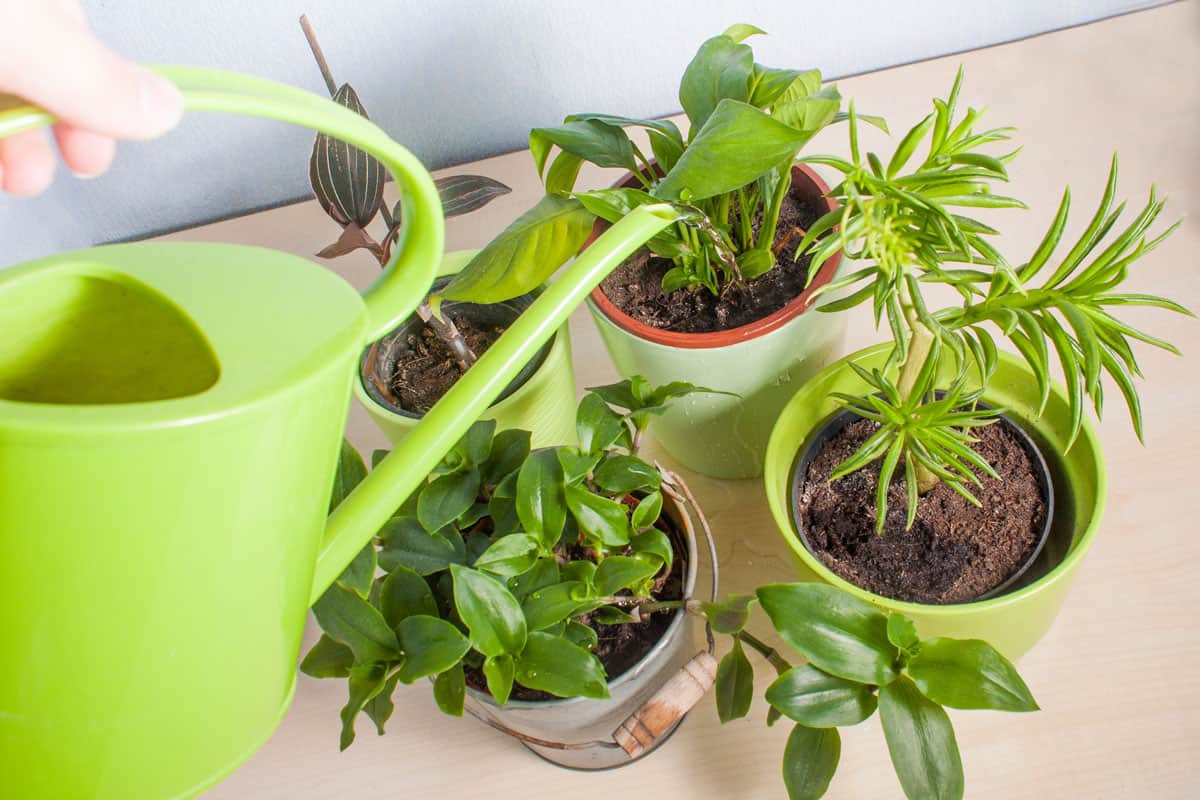
Inch plants are dormant during the winter months. Their dormancy means that you need to cut back on watering. During the plant's growing months, you need to keep the soil moist and well-draining.
In the fall and winter, you can allow some of the soil to dry out before watering. You want to do this because the plant isn't growing as rapidly and doesn't require as much water.
Allow the first two inches of soil to dry out for large plants before watering again. You should only allow up to the first inch of soil to dry out for smaller ones.
Humidity Levels
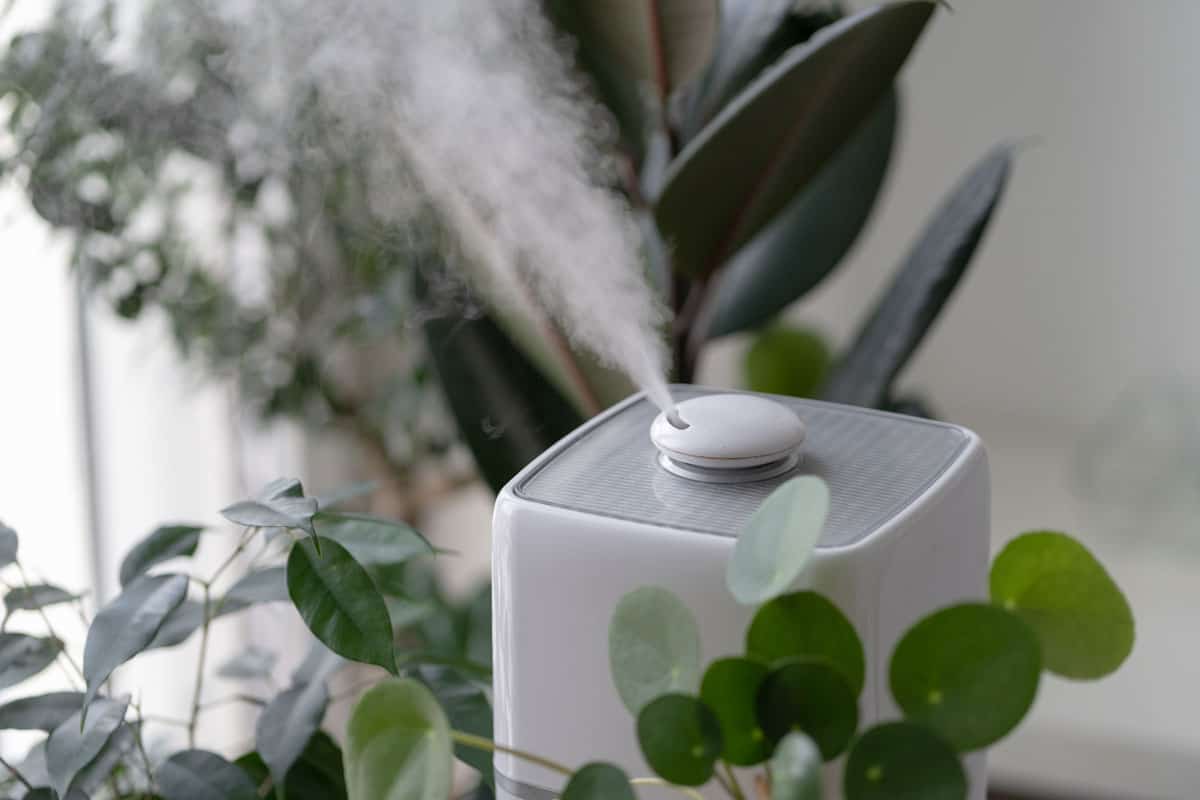
Your wandering dude will still need humidity during the winter. In fact, you may have to increase the humidity levels in your home during the winter. This is because most people use their heaters during this time. Yes, it keeps homes warm, but it also takes away the moisture in the air.
You'll know that you need to adjust your humidity levels if you notice leaves with brown edges or falling leaves. To increase your humidity levels, you can use a humidifier.
Another option is to use a pebble tray. Pebble trays are small dishes filled with rocks and water. You place your plant on top of it, which increases the nearby humidity.
Avoid Cold Drafts

Remember that inch plants are native to tropical regions with higher temperatures. They do well when indoor temperatures are between 60 and 80 degrees Fahrenheit. For the most part, this is within the range most at which people keep their homes.
However, be careful to avoid any cold drafts from your windows. Your inch plants must be brought inside when outdoor temperatures drop below 50 degrees Fahrenheit. A cold breeze, even indoors, can cause severe damage to your wandering dude.
Stop Fertilizing
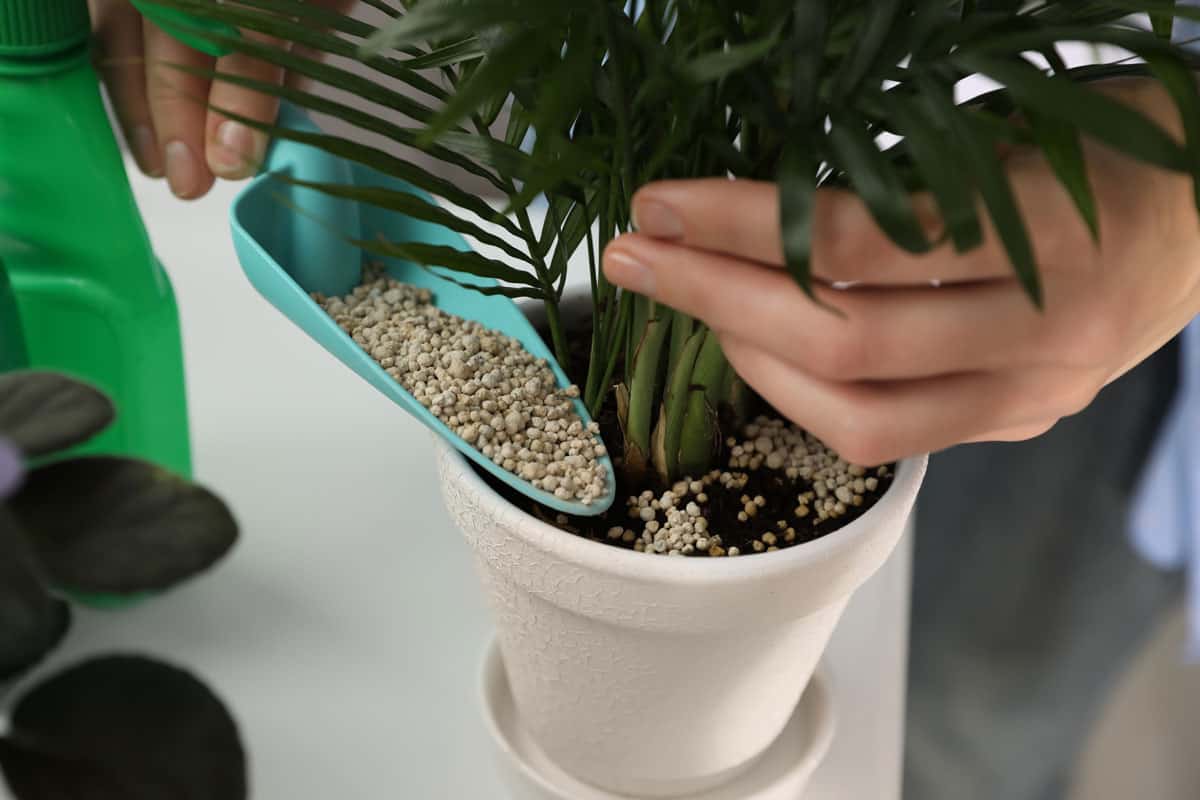
You should stop fertilizing your inch plants during the fall and winter months. Remember, the plants are dormant in the winter. Even if you see new growth, the plant isn't growing rapidly enough to warrant any fertilizing.
It can be challenging to determine if you've over-fertilized your plants. The symptoms can easily be confused with overwatering. However, keep an eye out for yellowing and wilting leaves and leaves dropping. You may also notice a crusty white surface on the soil.
Avoid Pruning
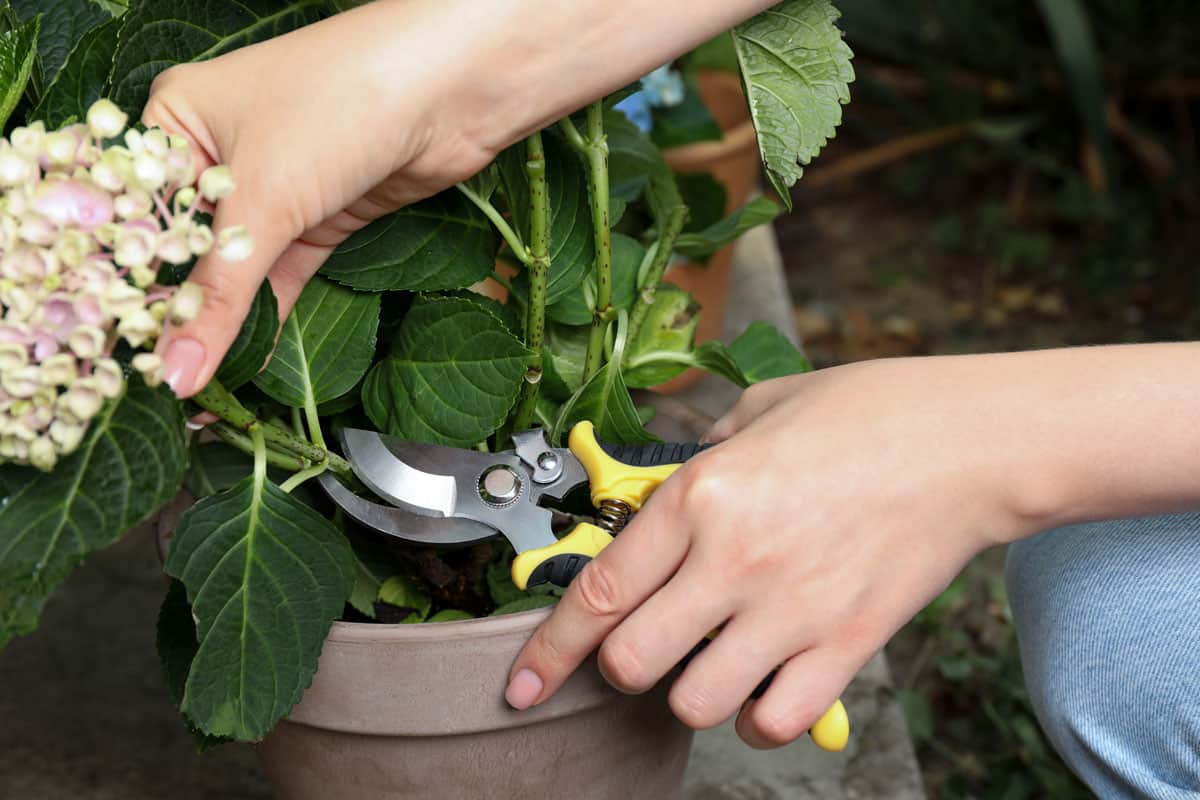
Technically, you can prune your wandering dude plant during the winter months. However, you need to be incredibly careful. New growth can occur when pruning during the fall and winter. Unfortunately, this can lead to weak and leggy growth.
The best time to prune your wandering dude is during the active growing period. These plants can handle a hard pruning in the spring.
Keep Sunlight Levels High

Wandering dudes prefer areas with bright indirect light when grown indoors. They prefer this amount of sunlight year-round. So, even though we get less light, your plant still wants the same amount.
Consider the area where your inch plant is currently. If your plant is at a north-facing window, you may need to move it. You can move it closer to the window or near a south-facing window. South-facing windows are best for getting light without any glare and heat like with east- or west-facing windows.
Another option is to use a growing light. This can help you control the amount of light without moving your plant.

Take a look at this full spectrum light on Amazon!
When To Repot Wandering Dudes
You shouldn't repot your wandering dudes in their dormant months. Changing containers when your plant isn't actively growing can cause shock or root rot.
If you're going to repot, first determine if your plant needs it. Tradescantia can be invasive . You don't have to worry about it overtaking your home. However, its invasive tendencies mean you may not have to repot it as often as you think.
If your wandering dude has roots growing out of its container or slower growth, you should switch to a larger container.
How To Repot
Select a pot that is at least two inches wider and deeper than your current container. It should also have drainage holes. You can also choose a pot that is wider than it is deep. These types of plants typically have shallow roots, so you don't necessarily need the extra space on the bottom.
Water your plant and put on a pair of gloves before repotting your wandering dude. You'll have to work carefully and away from pets and kids. These plants are toxic.
Move your plant's vines to the side and lay the pot horizontally. Then gently remove the plant from its container. You can put your gloved hand between the soil and the container wall to move the plant out.
Put a layer of soil at the bottom of the new container. Then make sure the plant's root ball is untangled. Next, put the plant into the container and fill the sides up with soil. Water the inch plant from above to help settle the soil.

Check out this pot with a drainage hole on Amazon!
What Problems Do Wandering Dude Plants Have?
For the most part, there are no serious issues that you have to worry about for the wandering dude.
However, you should be on the lookout for a few common diseases. Root rot is commonly caused by poor drainage or overwatering. Stem rot can also occur if moisture is left on the plant.
Wandering dudes can be affected by aphids, mealybugs, spider mites, thrips, and slugs. If your plants are being grown exclusively as houseplants, then you don't have to consider slugs.
You should still monitor your plant for signs of other small pests. When left unchecked, aphids and mealybugs can attract ants, and thrips can spread disease to other parts of the plant.
Final Thoughts
The wandering dude, or wandering Jew, is an easy-to-care-for tropical plant that requires a little bit of care to survive the winter.
Be wary of over-watering and cold drafts, which can be damaging for your plant. Keeping that in mind, you'll have a happy, healthy plant to prune and fertilize come springtime!
Are you looking for more wandering dude information? Check out one of the posts below.
Why Is My Wandering Jew Dying [And What To Do]
Will A Wandering Jew Climb A Trellis?
I look forward to receiving new gardening tips!
I always enjoy learning new things about gardening
Yes it help me very much a lot to understand and why it dries up and falls off
I like wondering who’s the pretty they’re pretty easy to take care of you can clip and reboot them make us more Fuller and bigger pinch back and they get full too and I’m going to try to send a picture if I can thank you 😊
I got some samples now I’m having them in the jar of water rewarding and see what happens soon as it works to get up small pots to see if it if I can get it going good 😊
Leave a Reply Cancel Reply
Your email address will not be published. Required fields are marked *
Name *
Email *
Add Comment *
Post Comment
Wandering Jew: Types, Care, and Propagation
Table of contents, wandering jew - an introduction.

Types of Inch Plants
- Tradescantia fluminensis: This variety has fleshy ovate leaves with white and green variegations attached to fleshy stems. It has triangular white flowers with three petals.
- Tradescantia zebrina: The variegated leaves resemble the stripes of a zebra, the purplish-green leaves have a silver edge. One of the hardiest and quickest growing wandering jew varieties.
- Tradescantia pallida: Also famous as the Purple heart plant for its deep purple foliage and light purplish-pink flower. It stands out amazingly both as ground cover and as hanging plants.
- Tradescantia blossfeldiana: The thick green leaves have a fuzzy texture with a white and green variegated upper side and a purple underside. The plant has clusters of beautiful blue, purple, white, and pink flowers.
- Tradescantia Sillamontana: This plant has beautiful symmetry with leaves growing on thick succulent-like stems covered in white fuzzy hair. It produces magenta flowers in season.
- Tradescantia spathacea: Also famous as ‘moses in a blanket’, ‘oyster plant’, or ‘boat lily’, it's almost succulent like in nature. It has dark green leaves with purple underside growing in spiral patterns
Wandering Jew (Tradescantia) plant care
The creeping-inch plants love bright indirect light but also do great with a few hours of direct light. Plant your wandering jew plant near a south-facing window where it can get at least 6 to 7 hours of bright indirect light. Growing your spiderwort in North-facing balconies and terraces is also a good idea. If the colour or variegations on the leaves start to diminish then it is a clear sign of low light. Shift your plant to an area with brighter light conditions.
The wandering jew plant likes its potting mix to be kept uniformly moist at all times but not soggy at all. Under indirect light conditions, water your wandering jew plant once per week or when the top soil dries out. Don't let the soil dry out completely. However, when watering your dried potting mix, water it in batches to ensure that the soil absorbs all the water and it just doesn’t run out of the planter. Water a little and then wait for a while for the soil to soak up the water before watering it again till it drains out of the drainage hole at the bottom of the planter.
The creeping inch plant is not very finicky about the soil it grows in. It thrives in a well-draining but rich potting mix. The key points to be kept in mind is allowing the topsoil to dry in between waterings and also aerate the soil once in a while. Since the spiderwort plant loves moist potting mix, it is very important that it is well-draining and well-aerated so root rot can be avoided.

Fertilisers
Use a well-balanced and generic houseplant fertiliser for your wandering jew plant. They are not heavy feeders and do well with both root and foliar application every 15 days. Use a good quality fertiliser like the Ugaoo Plant Tonic for this. Using NPK is also a good idea. Dilute the fertiliser as instructed and apply directly to roots once in 15 days and put it in a misting spray and do a foliar application too once in 15 days. The foliar application guarantees bigger and showier leaves. However, don't overfeed the plant as it causes the leaves to lose their variegations.
Propagating Wandering Jew Plant
Problems with the inch plant and how to deal with them, .
Share this:
- Share Opens in a new window.
- Tweet Opens in a new window.
- Pin it Opens in a new window.
- Email Opens in a new window.
- Whatsapp Translation missing: en.general.social.alt_text.share_on_whatsapp
- Betel Leaf Plant: Care, Benefits, and Propagation
- Dracaena : Care, Types, & Propagation
You may also like
A gardener's best friends: what are the benefits of using watering cans, why should you prefer organic fertilizers for plants, how to get rid of mushrooms in houseplants, 5 must-have pruning tools for your garden.
- Choosing a selection results in a full page refresh.
- ${ item.displayLabel }$
Please try with different query 0" >or try clearing Filters. .
Please try again or visit our home page..

Reset your password
We will send you an email to reset your password
Welcome back! Sign in with
New here? Create an account
Create an account with
Or use your email
Already have an account? Sign in
Growing Wandering Jew Plants – How To Care For Spiderwort Plants
Updated on November 17, 2020
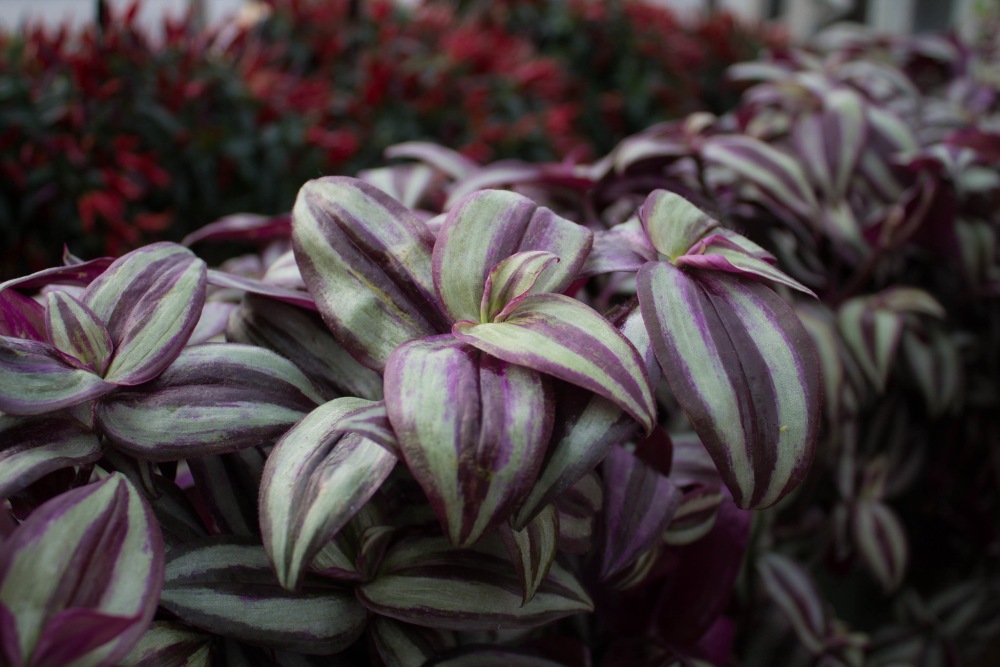
Many horticulturalists claim that the wandering Jew plants are the perfect houseplants no matter where you live or how little skill you have with plants. There are many facts to support this claim even if it sounds outlandish and we’ll go through in detail. But the question here is which wandering Jew plants to grow? This umbrella name refers to a wide variety of plants in the Tradescantia family. Each one of them has some value to add to your home. From brighter blooms to more colorful foliage. But all these varieties of the wandering Jew plants share one thing in common and that is they are easy to grow and care for.

Reasons to Consider Wandering Jew Plants in your Home
So let’s dissect this claim that the wandering Jew plants are perfect for all homes. We have covered many plants that were easy to grow and didn’t need much attention. What makes the wandering Jew plant so special? Well, there are a few reasons for that.
- These plants are natural air purifiers . The wandering Jew plants absorb carbon dioxide and toxic particles out of the air leave your house smelling fresh and healthy.
- In the realm of houseplants, this species likes to get attention with their showy foliage .
- They also absorb heavy metals out of the soil.
- The wandering Jew plants are known to self-propagate. They practically ask for no input from you when they reproduce and make new plants.
- They are hardy plants that can handle drought, fluctuating lighting, poor soil, and many other adverse conditions.
- Even if they happen to die on your watch, you can still start a brand new plant just with a leaf node from the old one.
- They thrive in small pots or hanging from baskets where they make a real colorful splash with these delicate tendrils.
- Finally, there are many varieties to choose from and they are easy to find in your local nursery.
Wandering Jew Plants Basics
Native to South America, the wandering Jew plants (Tradescantia) are perennial evergreens that combine three types of plants under this common name. They’re sometimes called spiderwort, purple queen, and inch plant depending on whom you ask. But the fact that they’re tropical plants doesn’t mean you can’t grow them in your home. That’s the beauty of houseplants. You have control over the temperature and humidity levels allowing you to grow such exotic plants as these.
The one thing you need to keep in mind is that the wandering Jew plants are considered invasive species in many places. This is why you can’t grow them in your garden. Remember what we said about their self-propagation? Once they establish roots in an area, they spread out and claim new territories all the time. In a garden, this means they will soon take over and smother other plants in the garden before they jump over the fence and reclaim the neighbor’s garden as well.
Some of the species are flowering plants while others rarely bloom indoors. But even those that don’t flower, they still have dazzling foliage that renders the flowers redundant. Some varieties have striped green leaves with silver streaks that are a delight to look at.
Wandering Jew Plants Varieties
So which variety of the wandering Jew plants should you grow? The answer to that depends largely on your personal taste and preferences. So let’s take a closer look at each variety of this exotic family.
- Tradescantia Zebrina: One of the most popular varieties whose leaves compete for your attention with its awesome blooms. In general, the leaves are usually heavily patterned while the three-petal flowers are white. But the contrast is often breathtaking. The center of the leaves is striped in creamy patterns just like a zebra, hence the name. The rim of the leaves is usually silver that contrasts the blocks of dark green color.
- Tradescantia Fluminensis: This evergreen originates from Brazil and flowers throughout the year. With proper care and attention, it will stay with you for many years. The leaves are usually oval in shape and have a distinct glossy green look. At the end of each leaf is a node that grows out of a fleshy stem and develops into a root. If you don’t prune the plant regularly, it will spread out and claim every inch of space available. It has USDA hardiness zones between 9 and 12 and favors warm climates and plenty of sunlight.
- Tradescantia Pallida: A showy variety that hails from Mexico. Its leaves are the source of its pride. Each leaf is about 7 inches long and when it matures, it turns purple with red or green tips. The small flowers bloom in various colors from pink to white and lavender. Unlike other varieties, the pallida plant doesn’t grow tendrils, rather its fragile stems break easily and grow into new plants on their own. It doesn’t tolerate cold temperatures well especially if the temperature drops below 50 degrees Fahrenheit.
How to Grow Wandering Jew Plants
As with exotic or tropical plants, you need to recreate conditions similar to the plant’s original habitat. This ensures the wandering Jew plants will keep growing and flowering year after year in your house. The good news is, these evergreens are easy to grow. As we have seen, they even self-propagate. Here are the easy steps to grow the wandering Jew plants.
- The easiest way to grow any species of the wandering Jew plants is through a cutting.
- Use a clean and sterilized knife to cut a healthy stem of a mature plant.
- Remove any dried or crispy leaves and only keep one set of leaves near the top of the stem.
- Put the stem in a glass full of water and keep it in a lit spot without being exposed to direct sunlight.
- After about a week the stem will grow roots. It might take longer than a week if the room is too cold.
- When the roots are about 2 inches long, it’s time to pot the plant.
- Fill a medium-size pot with a general-purpose potting mix . You can add peat moss, worm castings , or oak bark. However, make sure not to include peat.
- Make a hole about 4 inches deep and two and a half inches wide. Place the seedling in it and cover the hole with soil.
- Water the pot well until the water flows out of the drainage holes at the bottom.
- Keep the soil moist for the next couple of weeks to help the roots grow and establish.
Wandering Jew Plants Care
And that’s all you need to do to grow the wandering Jew plant. It’s that easy. But now, of course, comes the hard part. How to keep it growing and at the same time manage that amazing fast growth rate.
Most houseplants need well-drained soil. The wandering Jew plant thrives in loamy or sandy soil while it struggles in clay or alkaline soil. If you’re not sure that the soil drains well, add one-third portion of perlite and mix well. Many experts recommend you add a layer of gravel at the bottom of the pot to improve drainage.
Sunlight is important for the success of the wandering Jew plant. In fact, those bright three-petal flowers will not bloom without sunlight. In that respect, this perennial makes a distinction between morning sun and afternoon sun. It prefers the afternoon sun so always keep it on a window sill that faces the south or west. North and east-facing windows get the morning sun. The leaves of the plant will tell you if it’s not getting enough sun. Their color will fade and they turn yellowish. If the sun-deprivation continues, the plant might die.
Moisture is the operative word when it comes to watering. You wouldn’t want the soil to get wet but if you let it dry out, that will hurt the wandering Jew plant too. So it’s more of a balancing act. You wait for the top 3 inches of the soil to go dry before you water it. When you irrigate it, you don’t soak the soil. The roots are sensitive to water and don’t function well in waterlogged soil. This could lead to root rot, drooping leaves, and wilting stems.
Many horticulturalists recommend that you use worm castings as a slow-release fertilizer that feeds the wandering Jew plant slowly for weeks at a time. As an alternative, you can apply general-purpose liquid fertilizer at half strength. This means you should dilute it by adding about 50 percent water or using half the recommended dose. The best times to apply fertilizer are in the growing season. If you notice the tips of the leaves turning brown or looking dry, that could be the result of using strong fertilizer.
That’s where it gets serious. The wandering Jew plants are known for their fast growth rates. If left alone, they’ll grow all over the place and project a messy look. Not to mention that the plant becomes leggy. That’s when it focuses on growing long stems while leaving the base bare and ugly. Use your pruning scissors regularly to trim new shoots and keep the foliage dense and in good shape. Pinch the tip of the new shoots to encourage the plant to grow bushy.
Pests and Diseases
You need to watch out for spider mites. These little bugs feed on the leaves and flowers of the wandering Jew plant. You’ll notice small webs between the leaves, that’s a dead giveaway that you have a pest problem. Use neem oil to clean the stems and remove the webs. You could also dip a swap in alcohol and gently rub it over the leaves and stems to kill the pests.
As for diseases, the only two common ones are root rot and brown leaf tip. The first is the result of overwatering or poor-drainage soil. The second is caused by sun deprivation. Move your pot to a window that gets the afternoon sun to give the leaves their healthy and glossy look.
Your daily dose of crafts, recipes, beauty, fashion, living tips and home guides.
Leave a Reply Cancel reply
Your email address will not be published. Required fields are marked *
How to Grow and Care for a Wandering Dude Plant
Here’s how to care for this pretty trailing plant.
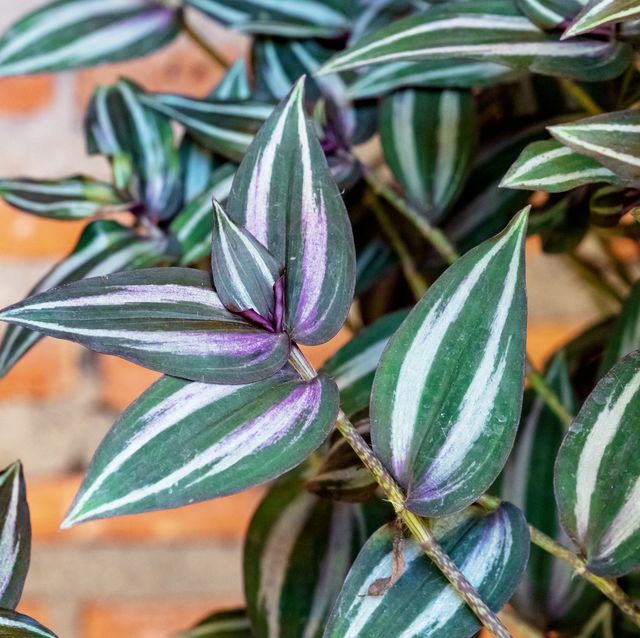
Country Living editors select each product featured. If you buy from a link, we may earn a commission. Why Trust Us?
With its long dangling stems, this plant tends to “wander” all over the place. Today, the plant often is called by its botanical name, Tradescantia, with “zebrina” referring to its silver striping.
It’s sometimes also called silver inch plant, but it can be confused with another plant, commonly called inch plant, Tradescantia fluminensis , which has solid green foliage.
Other varieties of wandering dude have become widely available in recent years, including the very popular nanouk type, which has foliage with pretty pinkish stripes and magenta undersides.
Native to Mexico, Belize, Guatemala and Honduras, the wandering dude usually is grown as a houseplant, but in USDA Hardiness zones 9 to 11 , it can be grown as a low-growing ground cover, too. ( Find your zone here .)
Read more: 15 Common Houseplants to Grow and Brighten Up Your Home
Ahead, learn everything you need to know about how to care for a wandering dude plant:
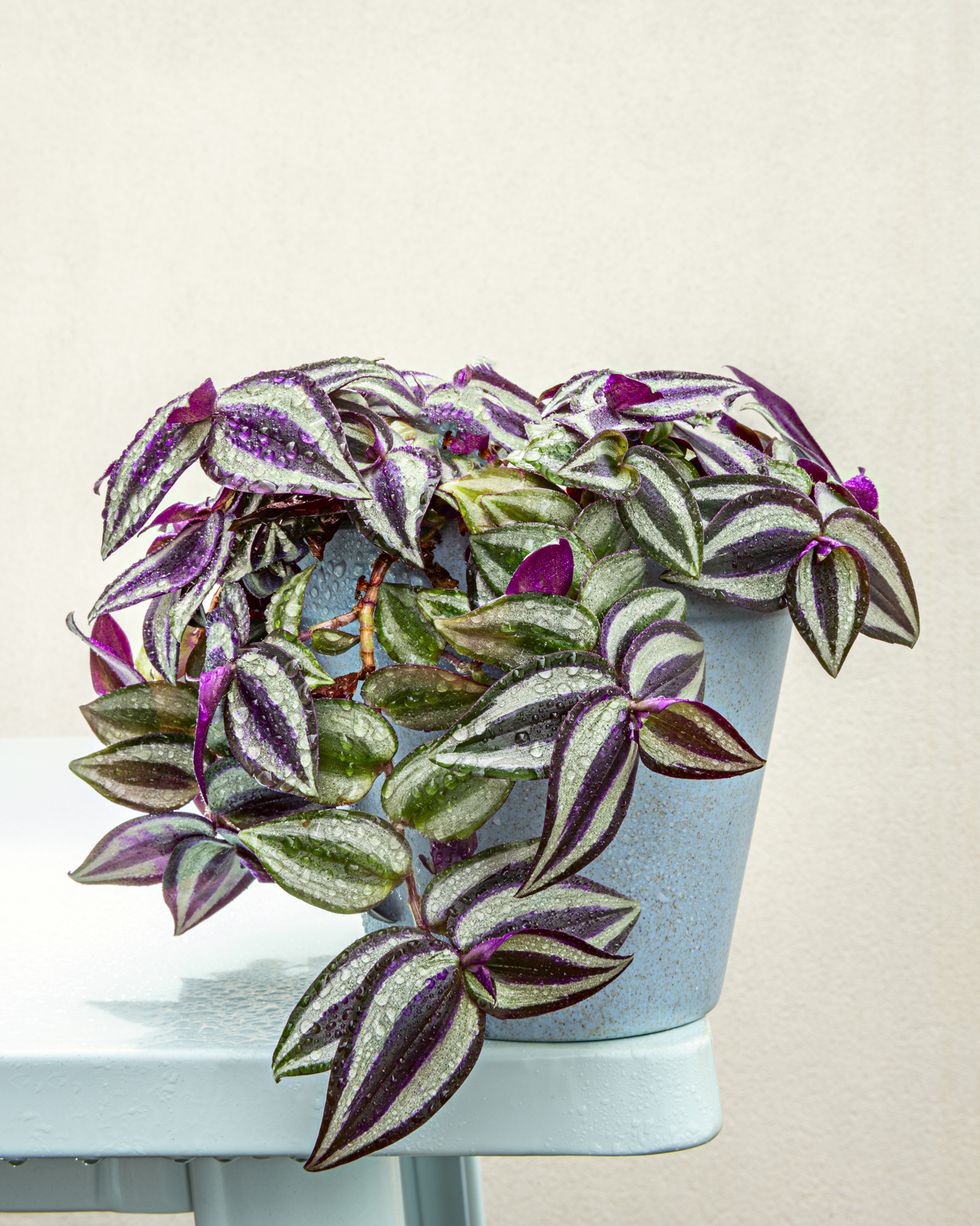
Wandering Dude Basic Info:
- Common Name: Wandering dude
- Botanical Name: Tradescantia zebrina
- Plant Family: Commelinaceae
- Type of Plant: Perennial, grown as houseplant
- Native Origin: Mexico, Belize, Guatemala, Honduras
- Sun Exposure: Full sun to part shade
- Mature Size: 6 inches tall by 1 foot wide
- Toxic to pets: Yes
Why Trust Us
I'm a garden writer with more than 15 years of experience growing houseplants, edibles, and landscape plantings. I also regularly trial new plant cultivars for performance and reliability, and test garden products to evaluate practicality and durability.
How Do You Care For a Wandering Dude Plant?
Give wandering dude bright, indirect light. If it doesn’t get sufficient light, this plant tends to get gangly and unattractive. Its purple coloring also may fade in low light, which means you should move it to a more brightly-lit room or use a grow light.
If your wandering dude is starting to get scraggly, simply snip off a few inches from the end of each stem to help stimulate the plant to push new, bushy growth. You can use plant snips or your fingers. You may need to pinch back frequently because wandering dude is a fast grower.
How Do You Water a Wandering Dude Plant?
You should water only when the plant feels mostly dry. Poke your finger in the soil before watering; if soil clings to your finger, wait a few more days and recheck.
If you let it get too soggy, that’s a sure way for it to get mushy and die. Like most houseplants, it’s better to err on the side of too dry, rather than too wet.
If you like, you can feed this plant with any general-purpose houseplant fertilizer, but it’s not entirely necessary.
Miracle-Gro Miracle-Gro Water Soluble All Purpose Plant Food, 3 lb
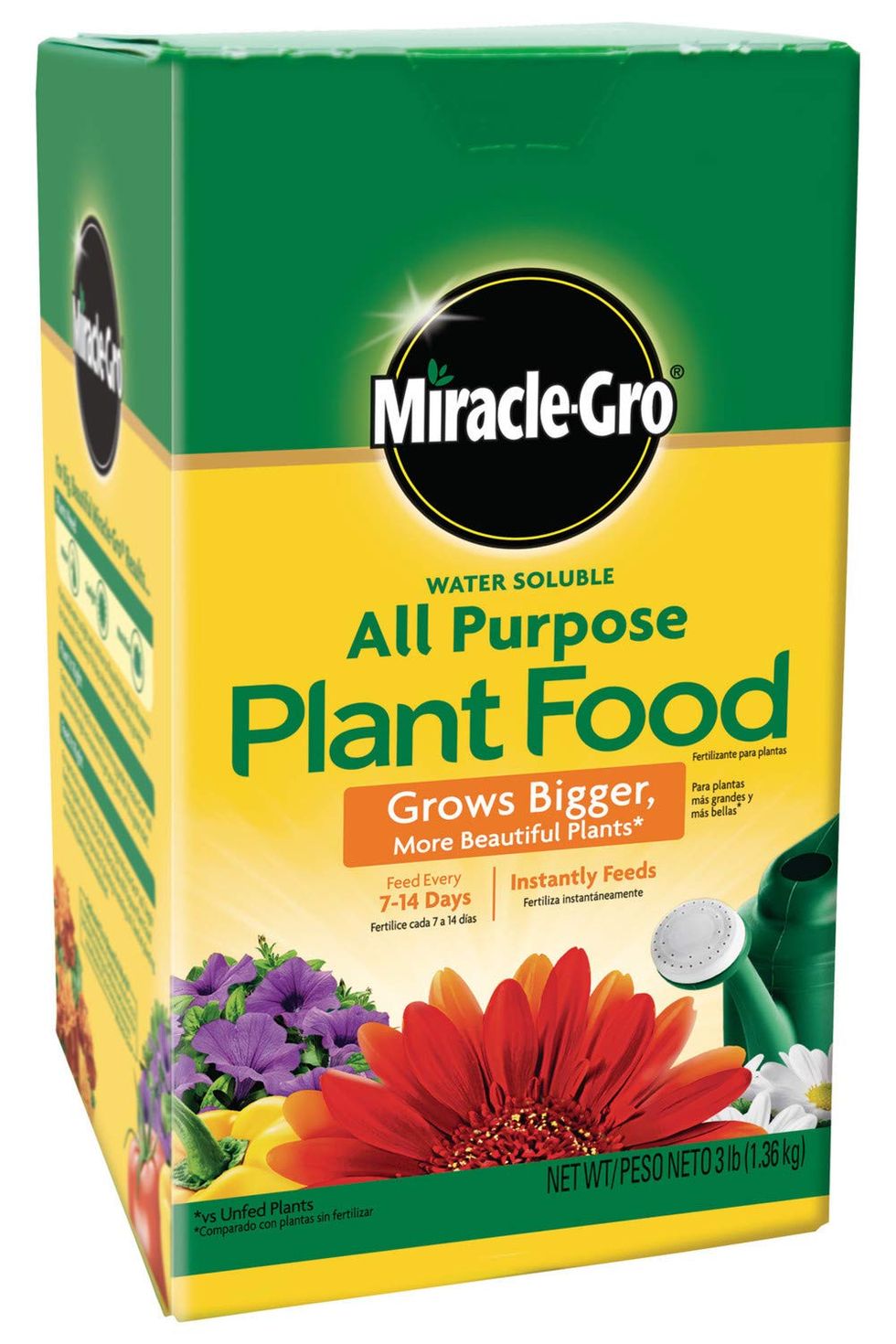
Can You Grow Wandering Dude Plant Outdoors?
Yes, it makes a great trailing plant spilling out of containers! Pair it with tall plants such as hibiscus, canna, elephant ears, or other tall, upright tropicals. If it starts to get leggy, just trim it back. Outdoors, it does best in full sun (northern climates) to part shade (southern climates). It may develop tiny pinkish flowers outdoors, though it rarely flowers indoors.
How Do You Propagate a Wandering Dude Plant?
Like pothos , this is a great plant to propagate to share with friends or to make new plants for yourself. Simply take a cutting, say, if it’s getting too long, then place it in a glass of water to root. Keep it in a bright spot in your home (not direct sunlight), and watch for roots to develop within about two weeks. Then plant in regular potting soil, and keep the soil lightly moist while it settles in.
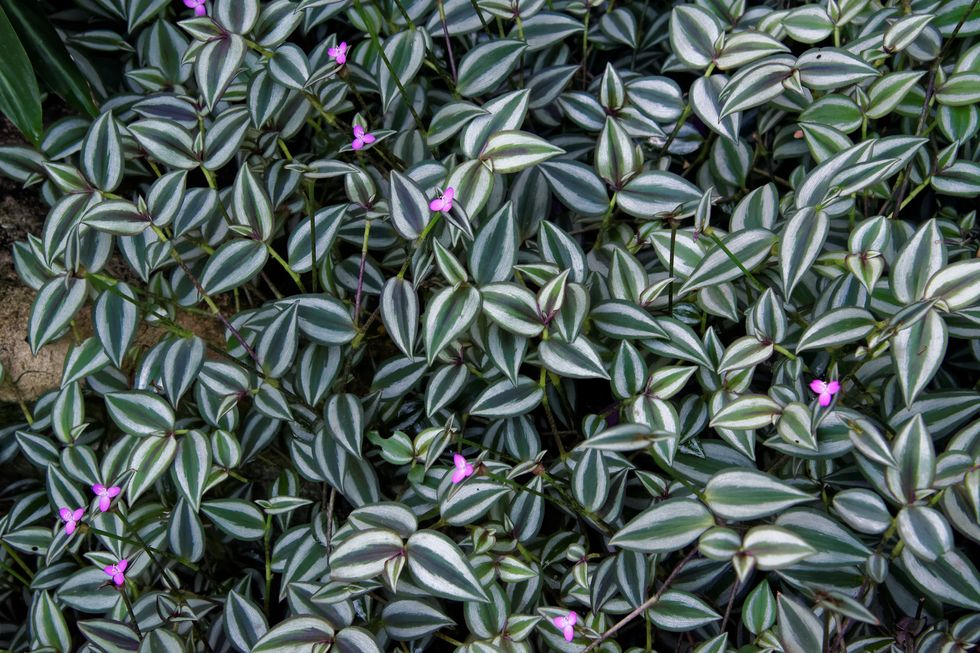
Is Wandering Dude Toxic to Pets?
According to the ASPCA , this plant is toxic to pets and may cause dermatitis, or irritation of the lips and mouth. But remember that any plant may cause vomiting or GI distress if eaten in large enough quantities, so keep this away from pets who are nibblers. Finally, call your vet ASAP if you suspect your pet has ingested it, even if you’re not sure. It’s always better to be safe than sorry!
In addition, the plant sap also may cause skin irritation in some people. Wear gloves when handling cuttings if you tend to have sensitive skin.
Read more: 28 Pet- Friendly Houseplants You Can Grow Without Worry
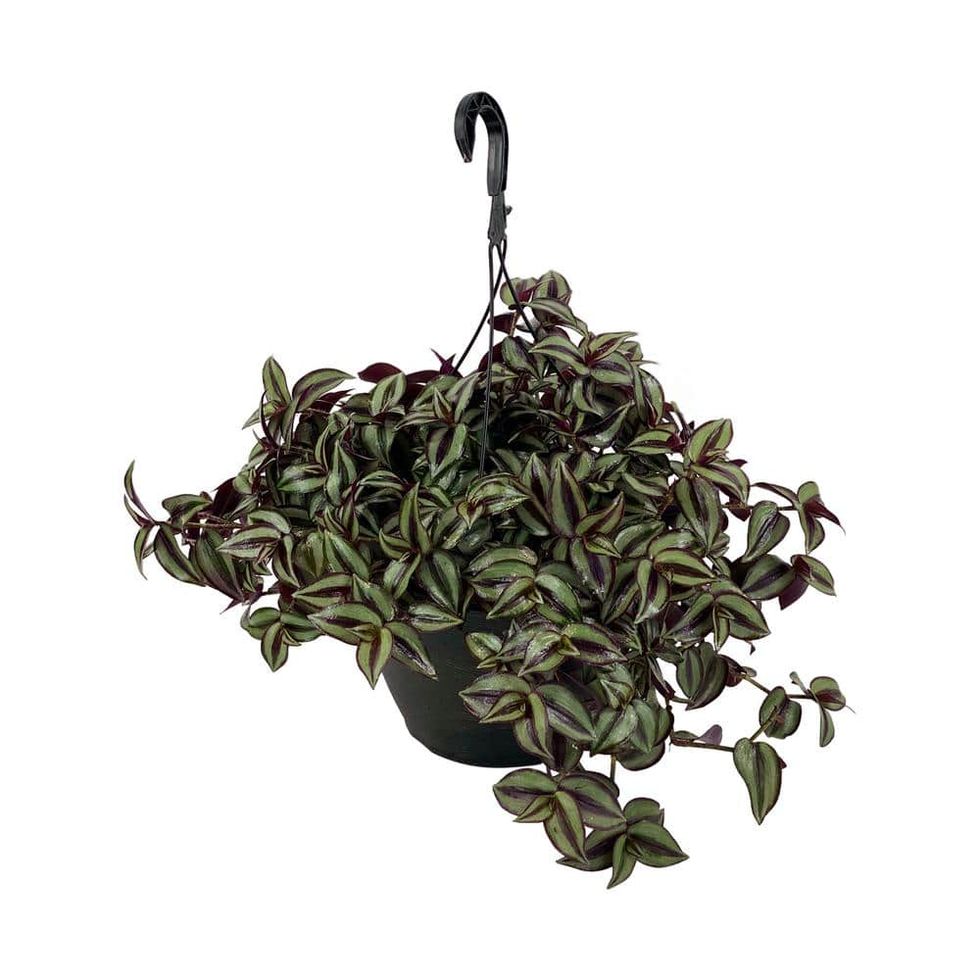
Vigoro Tradescantia in 11-inch Hanging Basket
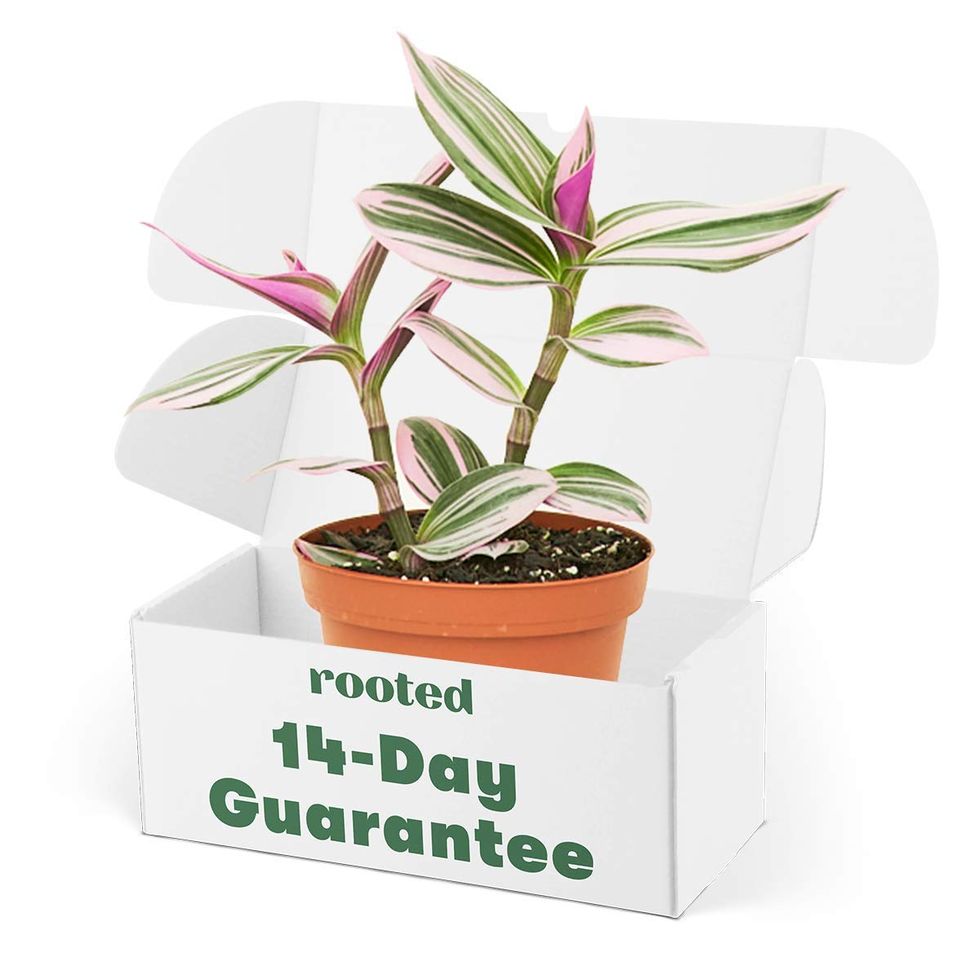
Rooted Tradescantia Nanouk, 4-inch pot
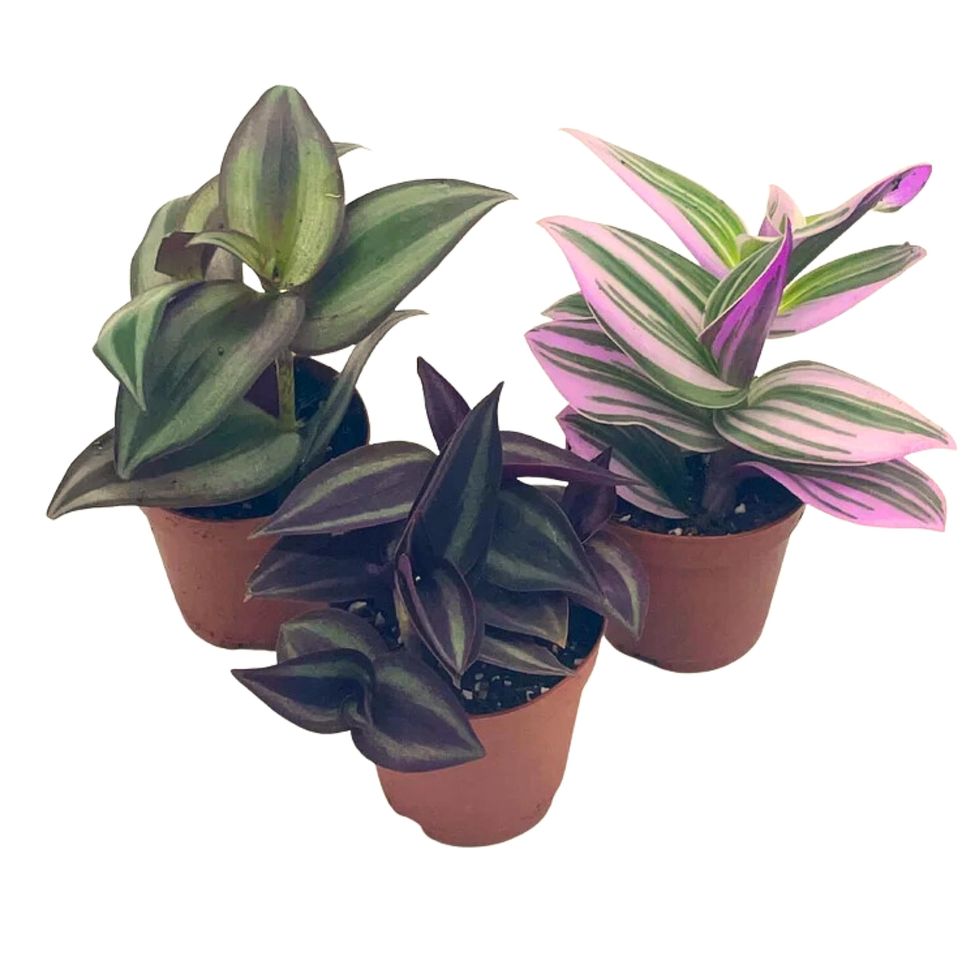
BubbleBlooms Wandering Dude Assortment
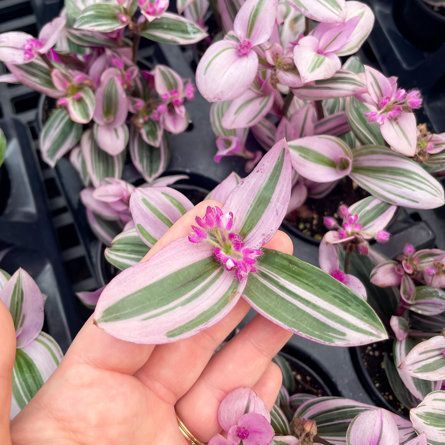
Wayfair Tradescantia Nanouk, 4-inch pot
Arricca Elin SanSone has written about health and lifestyle topics for Prevention, Country Living, Woman's Day, and more. She’s passionate about gardening, baking, reading, and spending time with the people and dogs she loves.
.css-1shyvki:before{background-repeat:no-repeat;-webkit-background-size:contain;background-size:contain;content:'';height:0.819rem;margin-bottom:0;margin-right:-0.9375rem;width:3.125rem;}.loaded .css-1shyvki:before{background-image:url('/_assets/design-tokens/countryliving/static/images/arrow.svg');}@media(max-width: 48rem){.css-1shyvki:before{display:none;}}@media(min-width: 40.625rem){.css-1shyvki:before{display:inline-block;}} Gardening Encyclopedia .css-unxkmx:before{background-repeat:no-repeat;-webkit-background-size:contain;background-size:contain;content:'';height:0.819rem;margin:0.7rem auto 0.9375rem;width:3.125rem;}.loaded .css-unxkmx:before{background-image:url('/_assets/design-tokens/countryliving/static/images/arrow.svg');}@media(max-width: 48rem){.css-unxkmx:before{display:block;}}@media(min-width: 40.625rem){.css-unxkmx:before{display:none;}}

12 Big Leaf Houseplants You Need ASAP
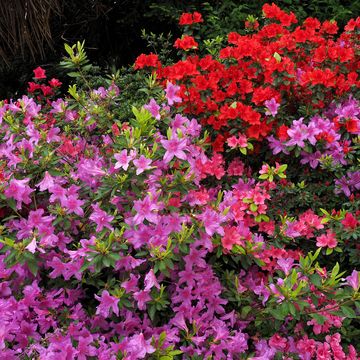
How to Grow Beautiful Azaleas

18 Spring Vegetables That Are Best Right Now

86 Essential Garden Flowers (With Pictures)
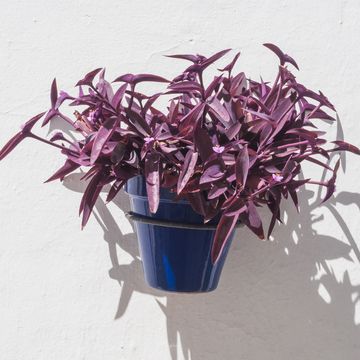
Here's How to Keep Purple Heart Plant Colorful
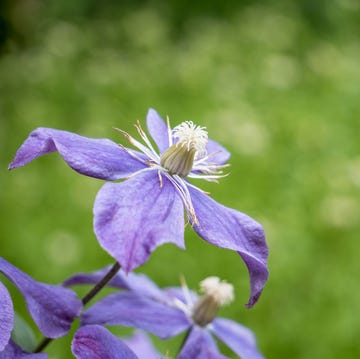
Your Guide to How to Plant and Grow Clematis

21 Indoor Plants to Breathe Life Into Your Home

Get Started on Your Spring Garden Plan Now
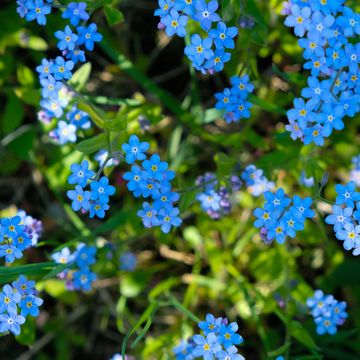
Here's How to Grow Forget-Me-Not Flowers
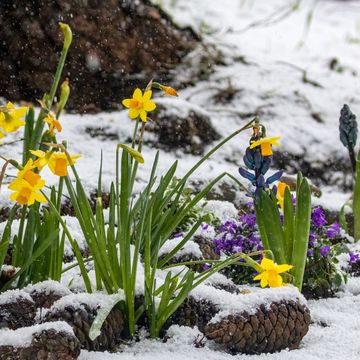
20 Winter Flowers That Add Life to a Snowy Garden
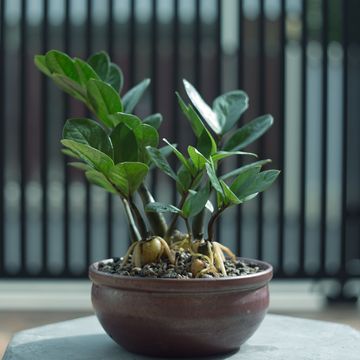
How to Care for a ZZ Plant
What are we looking for?
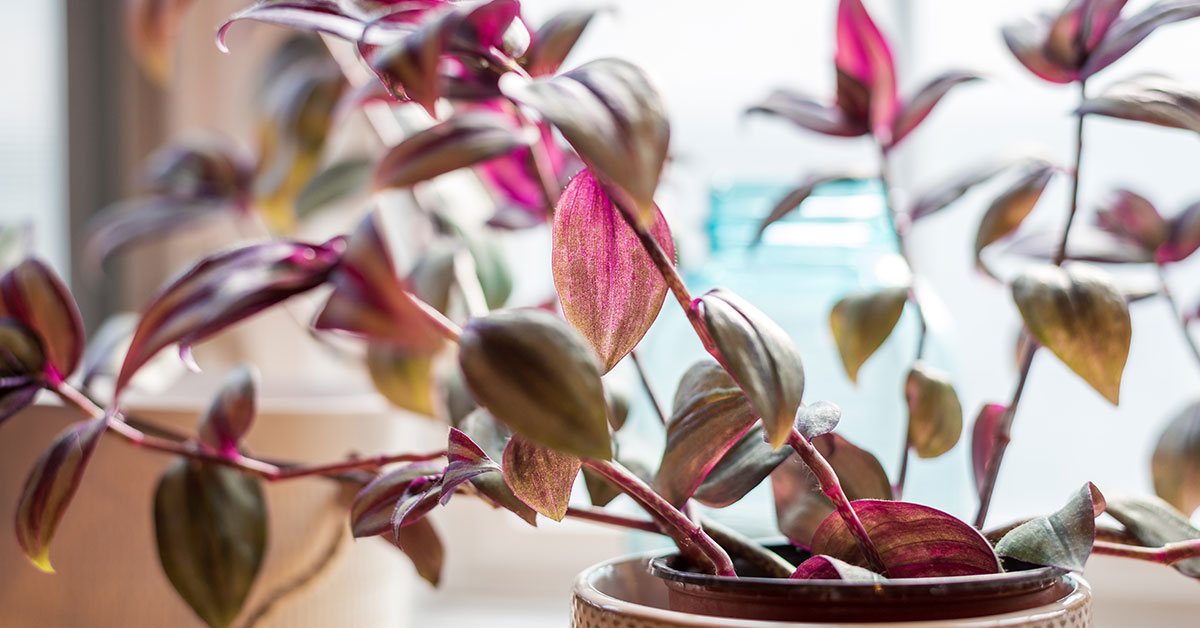
Why Your Wandering Jew Is Dying & How To Fix It

If you’ve noticed your Wandering Jew is dying or showing signs of distress, it’s important to identify the potential causes to effectively address the issue. This article aims to shed light on why your beloved Wandering Jew might be experiencing a decline and provide practical insights to help you revive it.
From improper watering practices and inadequate lighting to pest infestations and nutrient deficiencies, we’ll explore the various factors that could be contributing to your plant’s deteriorating health.
By understanding these potential causes and implementing the appropriate solutions, you’ll be equipped to save your Wandering Jew from further decline and restore it to a thriving state. So let’s dive into the possible reasons why your Wandering Jew is struggling and discover the steps you can take to bring it back to life.
Signs your Wandering Jew is dying
There are several signs that can indicate your Wandering Jew is dying or ill. Here are some common signs to look out for:
- Wilting: If the leaves of your Wandering Jew plant appear limp, droopy, or withered, it could be a sign of underwatering or overwatering. Check the soil moisture level and adjust your watering accordingly.
- Yellowing Leaves: Yellowing foliage may indicate various issues. It can be a result of overwatering, root rot, inadequate light, nutrient deficiencies, or pests. Assess the growing conditions and address the underlying cause.
- Browning Leaves: Browning and crispy leaves can indicate underwatering or exposure to direct sunlight. Ensure your plant is receiving adequate water and protect it from harsh sunlight.
- Leaf Loss: Excessive leaf drop or shedding is a distress signal. It can be triggered by changes in environmental conditions, insufficient light, overwatering, or pests. Identify the cause and take appropriate measures to rectify the issue.
- Stunted Growth: If your Wandering Jew plant’s growth has slowed down significantly or there is no new growth for an extended period, it could be a sign of unfavorable growing conditions, inadequate light, or nutrient deficiencies.
- Pest Infestation: Noticeable presence of pests such as spider mites, mealybugs, or aphids can weaken the plant and cause it to decline. Inspect the leaves and stems regularly, and take prompt action to eliminate pests if detected.
- Root Problems: If you notice a foul odor coming from the soil, root rot, or mushy and discolored roots when you inspect the plant’s root system, it indicates root problems. Overwatering, poor drainage, or fungal infections can contribute to root issues.
If you observe any of these signs, it’s important to assess the care and growing conditions of your plant, as it’s likely your Wandering Jew is dying or ill. Adjust watering, lighting, and environmental factors accordingly. In some cases, providing appropriate care can help revive a struggling plant. However, if the signs persist or the plant continues to deteriorate, it may be difficult to save and it might be necessary to consider replacing it.
Reasons why your Wandering Jew is dying and how to fix it
In this section, we will explore common reasons why your Wandering Jew plant (Tradescantia genus) may be experiencing distress or on the verge of dying. Understanding these issues can help you identify the root causes and take appropriate steps to revive your plant.
Wilting in a Wandering Jew plant (Tradescantia genus) can be caused by various factors, and identifying the underlying issue is crucial in determining the appropriate fix. It’s one of the more common signs your Wandering Jew is dying. Here are some common reasons why a Wandering Jew plant may be wilting and potential solutions:
- Underwatering: If the plant is not receiving enough water, it can lead to wilting. Check the moisture level of the soil by inserting your finger into the top inch of soil. If it feels dry, it’s time to water. Ensure thorough watering, allowing water to reach the root zone. Adjust your watering schedule to keep the soil slightly moist but not waterlogged.
- Overwatering: Conversely, overwatering can also cause wilting. Excessive moisture can lead to root rot, suffocating the roots and preventing them from taking up water properly. Allow the soil to dry out slightly before watering again. Ensure the pot has drainage holes to allow excess water to escape.
- Temperature Extremes: Wandering Jew plants prefer moderate temperatures between 65-80°F (18-27°C). Extreme temperatures, such as excessive heat or cold drafts, can stress the plant and cause wilting. Move the plant to a more suitable location with stable temperatures and protect it from drafts or direct exposure to heaters or air conditioning units.
- Light Intensity: Insufficient or excessive light can lead to wilting. Wandering Jew plants thrive in bright, indirect light. If the plant is placed in low-light conditions, it may not receive enough energy for healthy growth. Move the plant to a location with brighter, filtered light. However, be cautious of too much direct sunlight, which can scorch the leaves. Adjust the light exposure to find the optimal balance.
- Nutrient Deficiencies: Lack of essential nutrients can affect a plant’s overall health and cause wilting. Ensure your Wandering Jew plant receives adequate nutrition. Use a balanced, water-soluble fertilizer specifically formulated for houseplants and follow the instructions for application. Be mindful not to overfertilize, as this can lead to fertilizer burn or other issues.
- Pest Infestation: Certain pests, such as spider mites, mealybugs, or aphids, can weaken the plant and cause wilting. Inspect the plant regularly for signs of pests, including webbing, small insects, or sticky residue on leaves. Treat any infestations promptly using appropriate organic or chemical controls, following the recommended guidelines.
- Root Problems: Root issues, such as root rot or inadequate root development, can impact a plant’s ability to absorb water, resulting in wilting. Check the root system for signs of rot, such as foul odor or mushy roots. If root rot is present, take immediate action by addressing the overwatering issue, improving drainage, and trimming away affected roots.
It’s important to assess the specific cause of wilting in your Wandering Jew plant and take appropriate action accordingly. Adjust watering practices, improve lighting conditions, provide proper nutrition, address pest issues, and ensure a healthy root system. By addressing the underlying problem, you can help revive your wilting Wandering Jew plant and restore its vigor.
Yellowing and browning leaves
Yellowing or browning leaves in a Wandering Jew plant (Tradescantia genus) can indicate various issues. It’s another very common indication that your Wandering Jew is dying. Understanding the potential causes and taking appropriate action can help address the problem. Here are common reasons for yellowing or browning leaves and potential fixes:
- Watering Issues: Both overwatering and underwatering can lead to leaf discoloration. Overwatering can cause root rot, suffocating the roots and inhibiting their ability to absorb nutrients. Underwatering can result in dryness and nutrient deficiencies. Adjust your watering routine to maintain slightly moist soil, allowing the top inch to dry out before watering again.
- Light Intensity: Insufficient or excessive light can cause yellowing or browning leaves. If the plant receives inadequate light, it may struggle to produce energy and essential pigments. Move the plant to a location with bright, indirect light. However, excessive exposure to direct sunlight can scorch the leaves. Adjust the light exposure to find the right balance.
- Temperature Extremes: Extreme temperatures, such as cold drafts or heat stress, can cause leaf damage. Wandering Jew plants prefer moderate temperatures between 65-80°F (18-27°C). Protect the plant from cold drafts and ensure it is not placed near heaters or air conditioning units that generate excessive heat.
- Nutrient Deficiencies: Lack of essential nutrients can manifest as yellowing leaves. Ensure your Wandering Jew plant receives balanced nutrition. Use a water-soluble fertilizer formulated for houseplants, following the recommended application instructions. This can help address any nutrient deficiencies.
- Pest Infestation: Pests like spider mites, mealybugs, or aphids can cause yellowing or browning leaves. Inspect the plant regularly for signs of pests, such as tiny insects, webbing, or sticky residue on leaves. Treat any infestations promptly using appropriate organic or chemical controls.
- Environmental Stress: Environmental stressors, such as excessive heat, low humidity, or sudden changes in conditions, can impact leaf health. Ensure a stable environment with appropriate temperature, humidity, and airflow to minimize stress on the plant.
- Aging or Natural Leaf Shedding: It’s natural for older leaves to turn yellow or brown and eventually fall off. Monitor the plant to differentiate between natural leaf shedding and abnormal leaf discoloration. Prune away any excessively yellow or brown leaves to promote new growth.
When addressing leaf discoloration, it’s essential to identify the specific cause and tailor the solution accordingly. Adjust watering practices, improve lighting conditions, provide proper nutrition, address pest issues, and create a favorable environment. With consistent care and attention, your Wandering Jew plant can recover and display healthy, vibrant foliage once again.
Leaf loss in a Wandering Jew plant can occur due to various factors. Understanding the potential causes and taking appropriate action can help address the issue. Here are common reasons for leaf loss and potential fixes:
- Natural Shedding: It’s normal for Wandering Jew plants to shed older leaves as part of their natural growth cycle. As new growth emerges, older leaves may yellow, wither, and drop off. This process is generally not a cause for concern unless it is accompanied by other signs of distress.
- Watering Issues: Overwatering or underwatering can contribute to leaf loss. Overwatering can lead to root rot, causing the plant to shed leaves as it struggles to take up water and nutrients. Underwatering can result in dryness and leaf damage. Ensure proper watering by allowing the top inch of soil to dry out before watering again. Maintain a consistent watering schedule without overwatering.
- Lighting Conditions: Insufficient or excessive light can cause leaf loss. Inadequate light can lead to weak growth and leaf drop. Ensure your plant receives bright, indirect light for several hours a day. Excessive direct sunlight can scorch the leaves, leading to leaf loss. Adjust the lighting conditions to find the optimal balance.
- Temperature Extremes: Extreme temperatures, such as cold drafts or heat stress, can cause leaf loss. Wandering Jew plants prefer moderate temperatures between 65-80°F (18-27°C). Protect the plant from cold drafts and ensure it is not placed near heaters or air conditioning units that generate excessive heat.
- Nutrient Deficiencies: Inadequate nutrition can contribute to leaf loss. Ensure your Wandering Jew plant receives balanced nutrition by using a water-soluble fertilizer formulated for houseplants. Follow the recommended application instructions to provide essential nutrients.
- Pest Infestation: Pests such as spider mites, mealybugs, or aphids can weaken the plant and cause leaf loss. Inspect the plant regularly for signs of pests, such as tiny insects, webbing, or sticky residue on leaves. Treat any infestations promptly using appropriate organic or chemical controls.
- Environmental Stress: Environmental stressors, including low humidity, sudden changes in conditions, or air circulation issues, can lead to leaf loss. Maintain stable environmental conditions with adequate humidity and airflow. Avoid exposing the plant to drastic temperature fluctuations or drafts.
By identifying the specific cause of leaf loss in your Wandering Jew plant, you can take the necessary steps to address the issue. Adjust watering practices, improve lighting conditions, provide proper nutrition, address pest issues, and create a favorable environment. With consistent care and attention, you can help minimize leaf loss and promote healthy growth in your Wandering Jew plant.
Stunted growth
Stunted growth in a Wandering Jew plant (Tradescantia genus) can be attributed to various factors. Understanding these causes and taking appropriate action can help address the issue. Here are common reasons for stunted growth and potential fixes:
- Inadequate Lighting: Insufficient light can result in stunted growth. Wandering Jew plants require bright, indirect light for several hours a day to thrive. If the plant is placed in a low-light area, consider moving it to a spot with brighter, filtered sunlight. Supplemental artificial lighting can also be used to provide the necessary light intensity.
- Temperature Extremes: Extreme temperatures, such as cold drafts or heat stress, can negatively impact growth. Wandering Jew plants prefer moderate temperatures between 65-80°F (18-27°C). Protect the plant from cold drafts and ensure it is not exposed to direct airflow from heaters or air conditioning units that can cause temperature fluctuations. Maintain stable and comfortable temperature conditions for optimal growth.
- Nutrient Deficiencies: Insufficient nutrients can lead to stunted growth. Ensure your Wandering Jew plant is receiving proper nutrition by using a balanced, water-soluble fertilizer formulated for houseplants. Follow the recommended application instructions to provide essential nutrients. Additionally, consider repotting the plant if it has been in the same soil for an extended period, as fresh soil can provide additional nutrients.
- Root Bound: When the plant’s roots become overcrowded in a small pot, it can restrict growth. Check the roots by gently removing the plant from its pot. If the roots are densely circling around the root ball, it may be time to repot the plant into a slightly larger container with fresh soil. This allows the roots to spread and encourages new growth.
- Watering Issues: Inconsistent or improper watering practices can hinder growth. Overwatering can lead to root rot, while underwatering can cause dehydration and stunted growth. Maintain a regular watering schedule, allowing the top inch of soil to dry out before watering again. Ensure proper drainage and avoid waterlogging the soil.
- Pests or Diseases: Infestations by pests or diseases can weaken the plant, resulting in stunted growth. Inspect the plant regularly for signs of pests, such as spider mites, mealybugs, or aphids. Treat any infestations promptly using appropriate organic or chemical controls.
- Environmental Factors: Environmental conditions, such as low humidity or poor air circulation, can affect growth. Provide adequate humidity by misting the plant’s leaves or using a humidifier nearby. Ensure proper air circulation to prevent stagnant conditions that can hinder growth.
By addressing these potential causes, you can promote healthier growth in your Wandering Jew plant. Evaluate the lighting, temperature, watering, nutrient levels, and overall plant health. Make adjustments as necessary to create optimal conditions for the plant’s growth. With time and proper care, you can help your Wandering Jew plant overcome stunted growth and thrive.
Wandering Jew plants (Tradescantia genus) can be susceptible to root rot, a fungal disease that affects the roots and can lead to plant decline or death. If root rot is why your Wandering Jew is dying, you’ll need to act fast.
Root rot occurs when the roots are consistently exposed to excess moisture, causing them to become waterlogged and leading to the growth of harmful fungi. Here’s an explanation of why a Wandering Jew plant may develop root rot, along with steps to fix it:
Overwatering: The most common cause of root rot is overwatering. When the plant is consistently watered excessively or sits in waterlogged soil, the roots become deprived of oxygen. This creates a favorable environment for fungal growth, leading to root rot.To fix root rot:
- Stop overwatering: Allow the soil to dry out between waterings. Only water the plant when the top inch of soil feels dry to the touch.
- Improve drainage: Ensure the pot has drainage holes to allow excess water to escape. If the plant is in a container without drainage, consider repotting it into a container with proper drainage.
Poor Drainage: Inadequate drainage exacerbates the risk of root rot. If the soil doesn’t drain well, excess water can accumulate around the roots, promoting fungal growth. To fix poor drainage:
- Adjust the soil: Use a well-draining potting mix specifically designed for houseplants. Adding perlite or coarse sand to the mix can improve drainage.
- Repot the plant: If the current soil is heavy and retains too much moisture, consider repotting the plant into fresh, well-draining soil.
Compact or Damaged Roots: Root damage or compacted roots can make the plant more susceptible to root rot. This can occur if the plant is root-bound or if the roots have been disturbed during repotting or other handling. To fix compact or damaged roots:
- Repot the plant: If the roots are tightly packed or damaged, gently loosen them during repotting to encourage healthy growth and prevent further complications.
- Trim affected roots: If you notice any blackened, mushy, or foul-smelling roots, carefully trim them with sterilized pruning shears.
Proper Watering Technique: It’s important to water the plant correctly to minimize the risk of root rot.To establish proper watering technique:
- Water at the base: Directly water the soil around the base of the plant, avoiding the leaves and stems. This helps prevent excess moisture on the foliage and minimizes the risk of fungal infections.
- Monitor moisture levels: Use your finger to check the moisture level of the soil. Water only when the top inch of soil feels dry.
By addressing the root causes of root rot and implementing appropriate corrective measures, such as adjusting watering practices, improving drainage, and ensuring healthy root conditions, you can help save your Wandering Jew plant from root rot and promote its recovery.
Related Posts

10 Plants That Are Toxic To Cats Pet Owners Should Avoid

14 Everyday Activities That Harm & Kill Wildlife

10 Ways To Get Rid Of Mosquitoes For A Mosquito-Free Summer

10 Houseplants Perfect For Low Light

Avoid Growing These Plants That Are Toxic For Dogs

10 Flowers That Bloom in April

8 Easiest Fruits To Grow For Beginner Gardeners

10 Strawberry Growing Mistakes To Avoid

10 Easy Herbs For Beginner Gardeners

9 Flowers That Symbolize Rebirth

These Common Bird Feeder Mistakes Could Be Killing Local Wild Birds

What You Can Do To Save The Endangered Rusty Patched Bumble Bee
Join thousands of gardeners who receive our weekly gardening tips 🌻.

Tradescantia Tricolor Care From A to Z
By: Author Daniel
Posted on Last updated: July 15, 2021
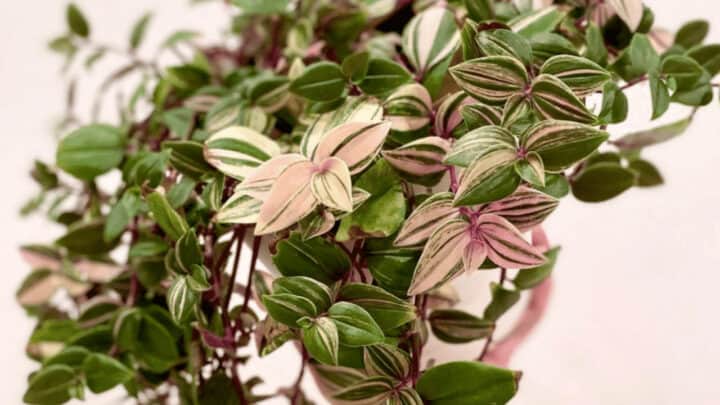
Sharing is caring!
- Facebook 11
(image credits, IG: oohyouplantsy )
I have a hide-away in my home that I escape to for some me-time. It is ultra-feminine and all done out in pink.
When I saw this stunning pink Tradescantia Tricolor plant at the nursery, I just had to have it! It offers the most glorious shades of pink transforming into a darker purple, interspersed with green.
Like all plants, the Tradescantia Tricolor has a difficult Latin Name. This one is Tradescantia fluminensis.
It is also known by other names including the Wandering Jew , Flowering Inch Plant, Wandering Willie, Wandering Gypsy, Purple Queen, Spiderwort, and Tradescantia.
What’s more, Tradescantia is a genus of 75 species of wildflowers. The name comes from John Tradescant, a botanist who lived during the 17th century.
The ‘wandering’ word refers to the fact that it spreads easily, wandering all over your window sill. They are very easy to grow at home. Most are native to South America where they grow as dense mats underneath forest trees.
To enhance the glorious pink shades, I place my Tradescantia Tricolor next to a Mosaic Plant , Fittonia albivenis. This is a trailing plant with deep pink veins in the green leaves. They make a great pair.
Let’s take a closer look at how to care for your Tradescantia fluminensis .
Table of Contents
Tradescantia Tricolor Care
For ideal Tradescantia Tricolor care, give it well-draining soil that will partially dry out between waterings. Fertilize with a good mix of peat, compost, mulch or humus, bark, pumice, or perlite. It thrives best in temperatures between 65°F to 75°F (18°C to 24°C). Temperatures should not drop below 50°F (10° C). The Tradescantia Tricolor wants bright light but not direct sunlight. Placing it near to a south-facing window is ideal.

Tradescantia fluminensis enjoys moist soil to thrive best. However, it must not be drenched or allowed to dry out completely.
Plant it in well-draining sandy soil. You can achieve this by mixing perlite into regular potting soil. Use a mix of 40% perlite and 60% potting soil.
Ensure that your pot has drainage holes at the bottom. This allows the excess water to run out and won’t cause the roots to become waterlogged and drown.
For ideal Tradescantia Tricolor care, I use natural organic additives. Including everyday materials like pumice or crushed bark, sterile garden compost, mulch, or organic manure gives you a rich, fertile soil that makes your Wandering Jew flourish.
Adding in some environmentally friendly coco Husk chips is a great way to introduce extra aeration into the soil. The Tradescantia Tricolor is not fussy about PH levels, try to maintain a neutral PH of around 7.0.
Tradescantia Tricolor does best in bright conditions with indirect sunlight. Allowing direct sunlight to fall onto the plant for too long causes the leaves to scorch.
Too little sunlight results in the leaves fading and not producing those lovely pinky shades.
Try to place your plant about 3 feet away from a south-facing window (if you are in the northern hemisphere), on a side table or high shelf. In this way, it gets the benefit of bright light but not direct sunlight. In general, 45 minutes of direct sunlight will be enough.
If you do need to stand it on a window sill, try to place a sun filter over the window. You can also use your décor skills and get it to nestle under another plant with large leaves, creating a natural umbrella.
If you prefer to plant your Tradescantia Tricolor outdoors, find a spot that gets bright light and limited direct sunlight.
Care tip for Tradescantia Tricolor: If your plant does not show healthy signs of variegated growth, ie, it is not displaying lovely different pink colors, it is probably getting too little light.
When it comes to watering care for your Tradescantia Tricolor, it is best to keep the soil moist. You need a balance between drenched and bone dry.
Watering once a week during the summer months is adequate. In winter, reduce watering to once every two weeks.
Because you are not drenching this plant, you should not create too much of a mess indoors. Place a plant saucer under your pot that is large enough to catch any water that may flow out.
When watering in winter, use lukewarm water, no plant responds well to an icy blast! I do notice that my Wandering Jew can get to the point of looking almost droopy. Then a good watering brings it back to life within 24 hours.
Tradescantia Tricolor care tip: You can also water from the bottom. This technique involves placing your pot into a tub or sink filled with a few inches of water. The drainage holes in your planter allow the water to slowly absorb into the soil without over-saturating it.
Temperature
Tradescantia species perform best at temperatures ranging from 65°F to 75°F (18°C to 24°C). They can, if necessary, withstand higher temperatures. If the temperature drops below 50°F (10° C), the leaves will suffer.
It will tolerate short-term exposure to cold weather but generally does not do well in the cold. If you live in a cold climate, consider growing your outdoor Tradescantia Tricolor in a container.
You can then bring it indoors during the winter months. All species of Tradescantia are Winter hardy in USDA hardiness zones 9 to 12.
Coming from South America, the plant does not require tropical temperatures to thrive. It is quite hardy, and as long as it is not exposed to frost you should be fine. It can even stand on a chillier window sill.
Your Tradescantia Tricolor is not overly fussy about humidity. It is not a desert plant nor a tropical plant, so the average house humidity of 30% to 45% found in a home should do fine.
In winter, running heaters and air-conditioners can dry out the air and change the humidity, so you will need to be aware of this.
If the humidity in your home is too high, at over 50%, this could result in the growth of mold and bacteria and will give your living space a musty smell. Installing a dehumidifier will help to solve the problem.
Tradescantia Tricolor care tip: I find that my plant responds well to a lovely soft shower from a watering can.
Although this does not increase humidity, it acts as a natural rain shower, wetting all the leaves and washing away dust and pests.
Make sure you do this outside and allow the plant to dry off before moving it back indoors.
Fertilizer
The Inch Plant loves to wander and grows fairly fast, spreading over window sills indoors and rocks outdoors. It does not require a serious fertilizing program.
Like many potted indoor plants, Tradescantia fluminensis does well with some extra fertilizer during the growing months of Spring through early fall.
I am a great supporter of eco-friendly living and that also applies to the plant fertilizers I use. I stay away from chemical fertilizers whenever possible.
My number one care hack for Tradescantia fluminensis is to buy or make my own natural organic fertilizer. If you have a liquid fertilizer, dilute it, and use it once a month.
Fertilizing plants outside of the growing season is not good. The fertilizer can end up harming the plant by burning the roots.
Natural organic fertilizers can be made using peat, pumice, perlite, mulch, coco husks, and crushed bark. A small compost making kit is a fun addition to any garden and makes good use of fallen leaves, dead flowers, and grass cuttings.
Propagation
The easy-to-grow Inch Plant is also easy to propagate. This can be done by simply snipping off a healthy stem, placing it into rich, moist soil, and watering from time to time.
You can also put the stem cutting into a tall vase of water and allow it to grow roots. Place the vase in a bright spot and keep an eye on it.
Roots will appear within a week. Remove the cutting and plant into your terracotta pot or unglazed planter.
Propagating your own house plants is a fun and rewarding experience, give it a try!
Tradescantia Tricolor gets its Wandering’ name because it loves to wander. It grows fairly fast and spreads over the edge of pots, along window sills, and over rocks. It also looks great as a ground cover next to pathways and walkways in a garden.
It has beautiful variegated pink shades, that darken to purple and are interspersed with green. The stems and leaves are soft and hairless.
The leaves are an oval shape with pointed tips. They are shiny and smooth and grow to about 1.25 to 2.5 inches (32 to 64mm) long.
The flowers are white and have 3 petals, about 0.5 to 1 inch (13 to 25mm) in diameter. The flowers appear in Summer in small clusters.
The best Wandering Jew growing condition is in a bright spot with indirect sunlight and average humidity.
This plant is a ground cover perennial. It does not require heavy pruning, but if it sprawls too much and becomes straggly, you should trim it back to keep it in shape.
Tradescantia fluminensis care tip: If your plant is producing only green leaves, your light conditions are not ideal.
It does this to conserve energy, as creating variegated leaves uses up more energy. Prune back the green leaves, allow it to recover and produce those glorious pink shades.
Tradescantia fluminensis is not fussy when it comes to pot size. It will thrive in a small pot for years and will grow happily in a large pot.
If you do want to repot your Inch Plant, Springtime is the best season to do this. Repot into a mix of fresh soil and perlite to boost growth.
You can add some gritty sand to the potting mix to enhance drainage. Water well but do not drench. Check that the PH of the soil is neutral at around 7.0.
Care tip: Ensure that your planter has drainage holes so that the water can flow out. You don’t want the roots to rot in stagnant water at the base of the pot.
Sieh dir diesen Beitrag auf Instagram an Ein Beitrag geteilt von D A I S Y (@oohyouplantsy)
Propagate Tradescantia Tricolor from cuttings
– This is best done in early Spring to late Summer, during the growing period
– Use a sterile sharp knife, scissors, or cutter
– Wear gloves as the sap can irritate the skin
– Select a stem that looks healthy and has a few sets of leaves
– Carefully cut off the stem at the base, where it joins another stem
– Remove the lower leaves by snipping off to leave a clean stem at the base
– You now have 2 options: propagate in soil or propagate in water
Propagating the cuttings in soil
– Prepare a pot with a mix of soil, gritty sand, and organic fertilizer
– Water well but don’t drench
– Push your finger into the soil and create a hole about 2 inches deep
– Place the offcut into the soil and pack the soil back to hold it firm
– Place the planter where it will get bright light but not direct sunlight
– Water well for the next few weeks
Propagating the cuttings in water
– Fill a clear vase, tall glass, or container with water
– Place the cutting into the water
– Keep it shallow enough so that the leafy section is above the waterline
– A slender glass works well as the leaves will balance on the top rim
– Fine roots will start showing in about 1 to 2 weeks
– Wait for the roots to grow to 1 to 2 inches long
– Plant into a pot as described above
Common problems with Tradescantia Tricolor
Pest control.
Like all plants, your Tradescantia Tricolor can be attacked by pests. Common pests that affect the Wandering Jew are spider mites and aphids .
An easy way to get rid of them is to give your plant a good shower and wash them off. If they persist, you can spray with a solution of insecticidal soap.
Tradescantia Tricolor care tip for pests: Make your own insecticidal soap. Use all-natural soap, not detergent.
Mix 5 tablespoons to 1 gallon of cooled, boiled water. Add in 1 teaspoon of vinegar and 1 teaspoon vegetable oil to get the solution to stick. You can also add a teaspoon of garlic. Pour into a clean garden sprayer that has a fine spray setting and spray the plant.
Leaves don’t have variegated colors
If you notice that your Tradescantia Tricolor is only producing green leaves, this is due to bad lighting. Bad lighting reduces the energy of the plant.
To create the gorgeous colors, it needs energy, so it will conserve energy and only create green leaves.
Leaves look scorched
If your leaves are turning brown or look scorched, your plant is getting too much direct sunlight. Move it to a more suitable position, or protect it with sunscreen if possible.
Plant looks scraggly and untidy
Tradescantia Tricolor grows fast and spreads. You need to keep it in shape by trimming now and then. Remove any dead stems and leaves. Trim back into the neat shape you want.
Rotting roots
This is a sign of too much water. Tradescantia Tricolor does not enjoy drenched soil. Ensure that your container has drainage holes and allow the soil to partially dry out.
Tips to grow Tradescantia Tricolor problem-free
– Avoid overwatering your Tradescantia Tricolor
– Keep soil moist but well-drained
– Ensure that your plant is in a bright spot, it does not enjoy the dark
– Do not place in direct sunlight
– Does not enjoy very dry or very humid conditions
– Fertilize during the growing season with organic mixtures
– Trim from time to time if it becomes scraggly
Frequently asked questions about Tradescantia Tricolor
Is tradescantia tricolor considered invasive .
In some countries, Tradescantia Tricolor is invasive. This is because it spreads fast outdoors and can become invasive. It grows as thick mats in forest areas, blocking out the light for other ground plants.
Can Tradescantia Tricolor grow indoors?
Yes, it makes a very attractive indoor plant in a decorative pot. It looks fabulous in a hanging basket, or on a high shelf where you can let the long stems flow downwards.
Is Tradescantia Tricolor easy to care for?
Yes, this is a great plant for beginners. It requires very little maintenance and is hardy and strong. You don’t want to be discouraged by losing your first plant. The Tradescantia Tricolor will flourish in a bright spot out of direct sunlight.
Is Tradescantia Tricolor poisonous?
Do you want a glorious plant with pink tones? The Wandering Jew is eye-catching and easy to care for. It is a great choice for a beginner to create a focal point in a room or on a patio, in a hanging basket.
Once you are successful in growing your Tradescantia Tricolor, you can add other Tradescantia plants to your collection. Take a look at the lovely Tradescantia occidentalis, Tradescantia zebrina, and the Tradescantia pallida.

Daniel has been a plant enthusiast for over 20 years. He owns hundreds of houseplants and prepares for the chili growing seasons yearly with great anticipation. His favorite plants are plant species in the Araceae family, such as Monstera, Philodendron, and Anthurium. He also loves gardening and is growing hot peppers, tomatoes, and many more vegetables.
Related Posts
You are reading this guide to learn more about the Wandering Jew Plant and its…
I love plants that offer an eye-catching burst of color. They sure put a smile…
Tradescantia Nanouk is not difficult to care for if you keep in mind its basic…
Are you looking for a care guide for Anthurium Andraeanum? The Flamingo flower is a…
Among my favorite houseplants is NJoy Pothos, the one that sparked my interest in having…
Several Calathea species are highly valued as houseplants, such as the Calathea Zebrina…
- Air Conditioning
- Easter Eggs
- Tablescapes
- Pillows & Throws
- Doors & Windows
- Raised Garden Beds
- Centerpieces
- Party Decor
In-depth Guides
Product reviews, rooms & spaces, living room.
- Fireplaces & Mantels
- Walkways & Paths
- Pools & Ponds
- Kitchen & Dining
- Laundry Room
- Home Office
- Windows & Doors
- Floors & Ceilings
- Ask DIY Question
- + Post Project
- + Post a new Project
- Saved Projects
- Notifications
- Account Settings
- Support • Privacy
- DIY Projects
Can a wilted Wandering Jew plant be saved? It was left in cold weather
It was on an enclosed back porch, but temperature dropped, and it is now very wilted looking.
Best plant bag freeze protection!
you can try to re-pot it in fresh soil and place in a bright location.once it re-adjusts to the normal house temperature give it a little trim
Keep well watered and hope for the best. If you can cut a piece, put it in water, maybe for a new plant start.
I would cut the damage off, bring it inside, water it sparingly and see if it puts out new growth. If it didn't freeze the root system it can be saved. If the roots froze, have a funeral and buy a new one.
Bring it in, water it with tepid water and hope for the best. Wandering Jew can be tenacious, it all depends on if it can survive the cold it got hit with.
It is possible to save a wilted Wandering Jew plant (Tradescantia zebrina) that has been left in cold weather, but it will depend on the severity of the cold damage. Here are a few steps you can try to save a wilted Wandering Jew plant that has been left in cold weather:
- Bring the plant indoors: If the plant is still outside, bring it indoors and place it in a warm, well-lit location.
- Check the soil moisture: If the soil is dry, water the plant thoroughly. Be sure to allow the excess water to drain away, as Wandering Jew plants are sensitive to over-watering.
- Check for pests: Pests, such as aphids or mealybugs, can cause a Wandering Jew plant to wilt by sucking the plant's sap. Check the plant for signs of pests and treat it as necessary.
- Prune away any wilted or damaged leaves: Removing any wilted or damaged leaves can help to improve the overall health of the plant.
If the plant is severely wilted or if the above steps do not help to revive it, it may not be possible to save it. In this case, it may be best to remove the plant and start anew.
Keep in mind that Wandering Jew plants are not tolerant of cold temperatures and should be protected from frost. To prevent cold damage in the future, be sure to bring the plant indoors or provide it with adequate protection during cold weather.
They are hardy plants. Repot the plant in fresh soil, cut is back (give it a good haircut) and see if it pulls out or not.
My mom used to take down her plants and let them sit in the bathtub and drain out after watering them. This allows the plant to really get soaked.
Related Discussions
Gnats - how to get rid of them.
Somehow my house and garden got tiny gnats that killed my fuchsia plant and fly everywhere. I have tried ALL the Web recommendations - soap and oil dishes, sand in th... See more
Marigolds growing! Should I pinch the buds?
My marigold plants are growing. I heard that pinching the buds until Autumn will allow them to grow without killing the plant. Is this true?

Growing garlic
Growing our first garlic, should we wait until the leaves are drying out before we pick it? Husband picked first one today along with our first potatoes.

How to keep mice out of your garden?
Hi everyone, I have mice in my garden destroying my vegetables and I have also noticed them in the barn and shed. Please can someone tell me how to prevent them from ... See more
What's the best flower/plant to grow in Texas?
I know that opinions vary, but what's your opinion?!I have great luck w Rosemary plants. Green all year long.
Squash Plants Large and Healthy and no Squash Growing?
2nd Season in a ROW! Squash plants growing large and healthy leaves and the stems near the roots are looking healthy and turning dark green, getting flowers that grow... See more
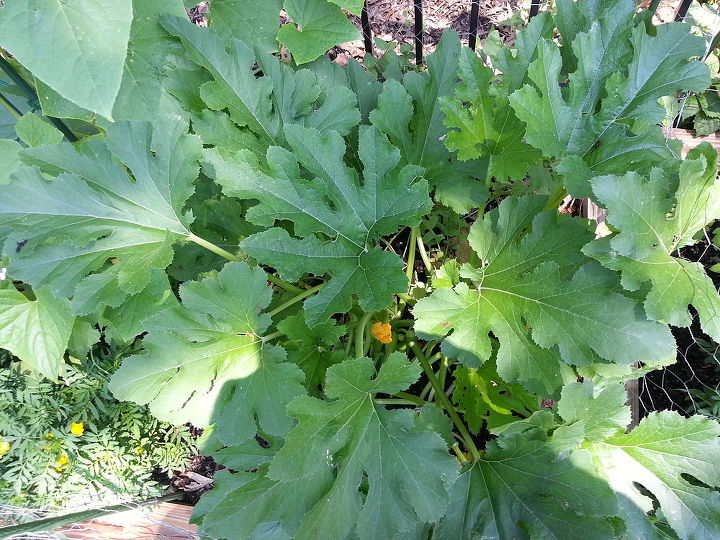
Trail of dead grass mystery?
Trail of dead grass appeared two weeks ago that starts in neighbor's yard and goes to the sidewalk, then continues past the sidewalk in a line into the grass into my ... See more
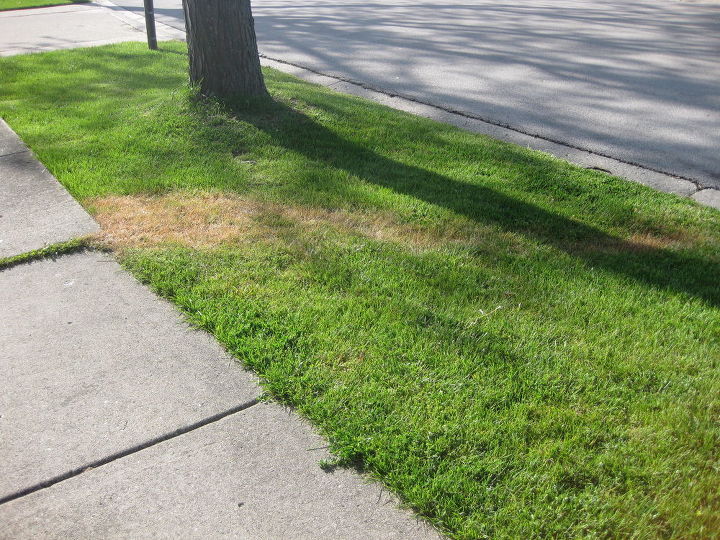
Suggested Project Book
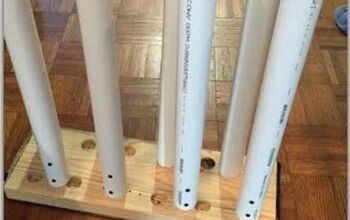
What Do You Do With Leftover PVC Pipes? Try These 27 Clever Uses
Government agencies communicate via .gov.sg websites (e.g. go.gov.sg/open) . Trusted website s
Look for a lock ( ) or https:// as an added precaution. Share sensitive information only on official, secure websites.
Wandering Jew
Wandering jew ( tradescantia zebrina ).
Other common names: Silver Inch Plant, 吊竹梅

The Wandering Jew is a creeping, herbaceous shrub that can grow up to 15cm tall. It has hairy leaves with silver and purple stripes on its upper side, while the underside is uniformly purple. Its stems are green and have purple shoots.
A perennial plant, the Wandering Jew is a great for indoor plant that is suitable for hanging planters and containers . It can also be used as a living mulch for shady areas.
Sun and soil needs:
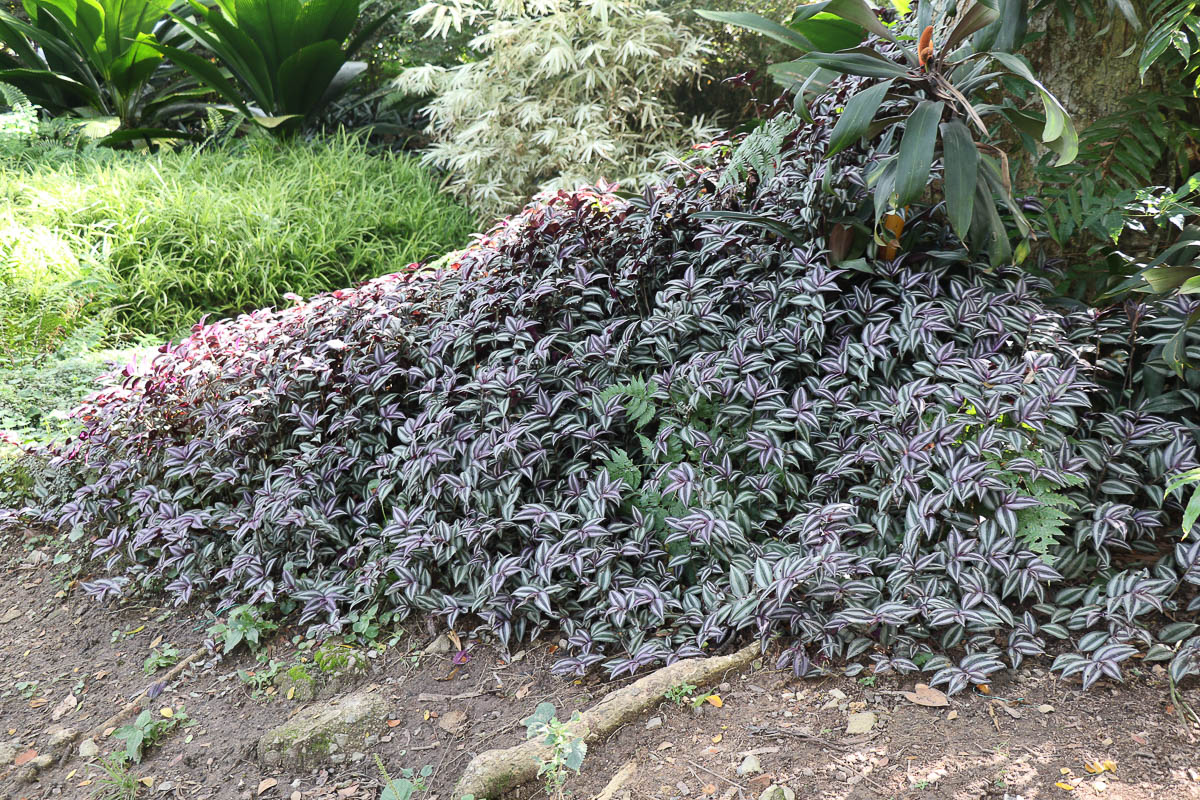
This plant thrives in 4-6 hours of indirect sunlight , and can tolerate up to 4 hours of direct sun. Plants do best in pots with loamy soil at least 10cm deep, or in true ground .These plants are vulnerable to root rot , so ensure that your pots drain well, and that your soil has plenty of organic matter to let the roots breathe.
_jacquelinechua.jpg)
Too much light will dull the variegation on its leaves while too little light will cause the purple hues to fade. Wandering Jews tend to get fertiliser burn, and should be fertilised only once every 3-4 months with a dilute balanced fertiliser or a slow-release fertiliser . Wandering Jews can become leggy and will need regular pruning to keep it bushy.
As with all potted plants, regular repotting once a year will prevent it from becoming root bound .
Propagation:
Wandering Jew can be propagated by stem cuttings .
Common problems & solutions:
This plant is relatively resistant to pests and disease if kept healthy.
Aphids , Mealy Bugs , and Spider Mites often infest the plant if it has underlying problems like repeated wilting from heat stress. Mechanical pest control methods like pruning the infested parts are the best methods for managing these pests in the short term, but resolving the underlying problem will prevent them in the long term.
Popular How To's
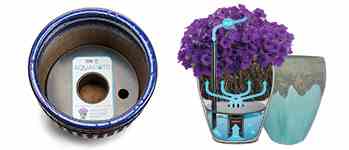
Bringing Plants Inside for Winter
FREE WEEKLY NEWSLETTER: Plants, Design Ideas, Gardening Solutions & More!
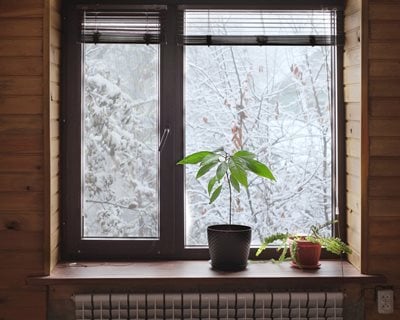
Instead of losing your beloved plants to winter weather, bring them indoors to enjoy them during the cold season-and take them back out when it warms up again. Photo by: Tache / Shutterstock.
When it starts to get cold out, it’s natural to make sure your pets are indoors and your kids have their scarves...but don’t forget to also take care your plants!
Every fall, Dennis Schrader—owner of Landcraft Environments in Long Island, New York—is asked the same questions about bringing plants indoors: Which plants can I bring inside? Will this one make it through the winter on my windowsill? Is there any way to save this plant for next year?
With proper care, some plants can reward you with color and fragrance during winter and be returned in spring to grace your garden beds again. Here, he offers a guide to overwintering plants including which plants can be brought indoors and how to care for them, so you get to enjoy them for another season.
HOW TO BRING PLANTS INSIDE
Here are 8 basic steps to bring your plants indoors for overwintering:
- Trim & clean up. Remove any dead, unhealthy, or leggy growth.
- Check for pests. Avoid bringing pests indoors that might infect your other houseplants such as mealybugs , thrips , or spider mites . Do a thorough check in the soil, on the tops and bottoms of leaves, and even the drainage holes of the pot—where pests like slugs sometimes hide.
- Repot if necessary. If your plant was already in a pot outdoors, you may choose to repot it for various reasons: your plant may be outgrowing its existing pot or maybe you simply want to use a different pot.
- Refresh soil. If you’re not repotting your plant, mix in and top the plant with fresh soil to add nutrients.
- Rinse & water. Giving your plant a good rinse is a good way to remove dust, dirt, and any bugs that might be hanging on before bringing it into your home. This is also a good time to give your plant a deep watering.
- Consider the plant’s needs when placing them indoors. Even the most rugged outdoor container plant will suffer indoors without the right conditions. Here are some things to keep in mind:
- Sunlight. If the plant needs bright light and received that outdoors, you need to make sure it’s getting adequate light indoors, too.
- Air circulation. Proper air circulation is crucial for indoor plants as it prevents sitting water, reducing fungus and rot.
- Drainage. Poor drainage can lead to waterlogged roots, leading to root rot and unhealthy growth.
- Water and fertilizer. Cut back water and fertilizer while plants slow their growth over winter.
- Humidity. Indoor air can be very dry in winter due to heating, so your plants will appreciate extra humidity from a humidifier, misting, or placing the pot on a saucer with pebbles and water (make sure the bottom of the pot is not sitting in the water).
- Gradually acclimate your plant to its new environment, if possible. Moving from outdoors to indoors can be quite a shock for a plant. If you’re able to, allowing the plant to adjust slowly will increase your chances of success. You can begin by bringing it in at night, then gradually increasing the time indoors until it’s inside 24/7.
- Keep the plant out of reach of animals and children, if necessary. See our list of common plants that are poisonous to dogs and cats .
As your indoor space begins to fill up with plants, you may have to limit the amount you bring indoors. If it does come to that, focus on the ones that are meaningful to you or the ones that would be costly to replace.
WHEN TO BRING PLANTS INSIDE
As a general rule, tender plants should be brought in when nighttime temperatures are below 50 to 55 degrees F, even if they are hardy for your zone. A plant’s roots are more exposed when planted in a container versus in the ground. In order for a containerized plant to stay outdoors, it should be rated for two zones colder.
WHICH PLANTS CAN BE BROUGHT INSIDE?
Citrus can handle one or maybe two mild freezes, but it’s best to keep them indoors during freezing winter nights if possible. Here, a calamondin orange tree is happy in the bright light next to a window. Photo by: Kristi Blokhin / Shutterstock.com
To have success with overwintering, it’s important to be familiar with which plants can successfully make the transition from outdoors to indoors. Many of the tender perennials we now consider annuals originally found their place in horticulture as houseplants and are excellent candidates for bringing inside.
Here are some of the most common plants to overwinter, but is by no means a comprehensive list. Research other plants online to determine if they are a good candidate for bringing indoors.
- Alternanthera
- Clerodendrum
- Polka dot plant
PLANTS TO LEAVE OUTSIDE
Some plants are not meant to be brought inside and saved for the following season. For example, there’s no point in trying to prolong the life of true annuals such as marigolds, zinnias, and nicotiana. Once they bloom and set seed, these plants are preordained to die, always with the hopeful promise that the seed they produce will germinate next season.
Here are some plants that should be tossed:
- Helichrysum
- Sweet potato vine
RELATED: 21 Best Indoor Plants Winter Care for Houseplants Annuals vs. Perennials: Understanding the Difference
JOIN 100,000 GARDEN LOVERS Sign up for weekly gardening inspiration and design tips
Get plant information, gardening solutions, design inspiration and more in our weekly newsletter.
* Required Fields We will never sell or distribute your email to any other parties or organizations. More about the newsletter
- Privacy Policy
- Cookie Policy
- Terms and Conditions
Copyright 2024. All Rights Reserved. Reproduction in whole or in part without permission is prohibited.
Join Us For Our Next Webinar Artistic Flourishes: Pots with a Purpose with Dan Benarcik April 18, 2024 @ 6PM EDT

JOIN 100,000 GARDEN LOVERS
Subscribe No Thanks
* Required | We will never sell or distribute your email to any other parties or organizations.
clock This article was published more than 45 years ago
How to Care for Spider Plants, Swedish Ivy, Wandering Jew
One of the most frequently asked questions at the recent Horticultural Demonstration and Show at Montgomery Mall was "What shall I do with my wandering Jew? It has green leaves at the tips but the rest of the stems all the way back to the pot are brown and papery."
This stringiness of wandering Jew is characteristic of that family of plants. The plant should be pinched back regularly before the hanging branches become very long. This practice encourages new growth on the stems near the surface of the pot. You cannot restore the brown stems to life. Cut them off. Use any good green growth at the tips as cuttings; either root them in water and plant them later or insert them in the soil of the same pot to grow and fill in bare spaces in the pot.
Indoor gardeners sometimes write to ask where a certain plant can be found. Where can I buy Elfin Herb? Who sells Pink Polka Dot or Satin Pothos?
A search for plants during the summer is often frustrating. Many stores, anticipating less demand, have not replenished their stocks or have reduced the numbers of kinds of plants they offer. Also, during these months growers are busy propagating quantities of plants to supply the demand that will arise when the indoor gardening season begins in earnest as cooler days arrive.
Furthermore, throughout the year an extension selection of plants is not always available at plant stores. This is a situation that might be changed if indoor gardeners were to ask for greater variety. Requests for desired varieties by name would give growers a reason for supplying them.
A regular reader asks, "How can I get my spider plant to produce plantlets?"
Much has been written about trying to induce spider plants to bloom and produce plantlets. Research reported by Purdue University has shown that flowering and plantlet production are affected by day length. Short days, i.e. daylight for 8 hours and uninterrupted darkness for 16 hours daily, greatly increased flower and plantlet production.
The experience of others is that keeping the plant potbound results in the production of plantlets.
A grower of my acquaintance believes that when the plant is really it will produce plantlets (with good care), regardless of what the gardener does for it.
Grace Su, of Rockville, writes: "The leaves of my Swedish ivy keep turning yellow then falling down. Could you tell me what the reason is and what I should do?"
Your Swedish ivy has probably had too much water. Make sure that the pot's drianage hole is not clogged. Do not let the plant stand in water for more than half an hour. If the soil has become compacted, the roots may have rotted from lack of oxygen, in which case the plant should be repotted. This is a good time of year to take cuttings: select some of the remaining healthy portions of the plant and start some new plants for the coming indoor gardening season.
Doris Whitehurst, of Chevy Chase: "My newly purchased croton has tiny thin roots all over the surface of the soil in the pot. Is this normal for this type of plant? I thought I should repot it in a larger pot. It is about 11 inches tall and seems quite healthy on the windowsill in the office where it gets sun almost all day."
To determine if the plant is potbound, turn it upside down and jar the pot against a table or shelf to remove the plant from the pot. If the soil ball is a mass of entangled roots, allowing no leeway for additional growth, repotting is recommended. Use a pot of the next larger size and add fresh soil. Cover the surface roots lightly with some of the fresh soil. Water the plant and set it in bright light but out of the sunlight for a few days.
Terris Lester, of Fairfax Station: "I would like to know a safe and effective way to rid my Zebra plant of the small scale on the underside of the leaves. Also I would like to know precautions to be taken to be sure that insects are not brought into the house on plants brought in from the patio in the fall."
The safest way to remove the scale from the Zebra plant leaves to pick them off with your fingernails, or to lift them off very carefully with the point of a nail file or penknife.
Bringing plants into the house before frost will be the subject of a future column. In the meantime use preventive measures such as brisk spray from the garden hose or, if insects are present, use a rotenonepyrethrum houseplant insecticide, following instructions on the container explicitly.
Indoor Garden questions may be sent to Jane Steffey at The Weekly, The Washington Post, 1150 15th St. NW, Washington, D.C. 20071. Please include your address and telephone number.


IMAGES
VIDEO
COMMENTS
Change the water every 3-4 days. If you are growing it in soil, keep the soil moist. Avoid overwatering, In 7-10 days, you will see new roots developing on the cut end of the stem. Wait 1-2 weeks to allow a strong root system to develop then plant it in a container filled with potting soil.
Wandering jew plants are super easy to propagate. Take cuttings that are 3-4″ long, and include a couple of leaf nodes. Dip the cut ends into rooting hormone, then stick them in moist soil. Don't allow the soil to dry out, and keep the air around the cuttings humid. A propagation chamber makes this simple.
Fill a 6-inch to 1-gallon container that drains with a rich, well-drained potting mix. Water the soil to settle it. Make about a 2-inch indentation in the soil where you want to place the Wandering Jew cutting. Remove the bottom leaves from the cutting where you will be inserting it into the soil.
W andering Jew Plant Care. To keep your Wandering Jew plant thriving, ensure it receives bright, indirect sunlight. Keep it in average room temperatures of 60-75°F (16-24°C). Fertilize once a month during spring and summer. In winter, relocate the plant to a cooler area with temperatures of 54-59°F (12-15°C).
3. Pot your Wandering Jew plant. Fill the pot about two-thirds of the way with light, well-draining potting soil, then place the plant in the center of the pot. Add soil to surround and fill in the sides. Gently press down on the soil around your plant and water it until the soil is completely moistened.
Wandering Jew (Tradescantia zebrina) is a trailing evergreen perennial in its native habitat (USDA hardiness zones 9 through 12). Where it's not winter hardy, wandering Jew is grown year-round as a houseplant. Are wandering Jew plants toxic to cats and dogs? Wandering Jew is not considered outright toxic, but it can cause some skin irritation.
Move your plant's vines to the side and lay the pot horizontally. Then gently remove the plant from its container. You can put your gloved hand between the soil and the container wall to move the plant out. Put a layer of soil at the bottom of the new container. Then make sure the plant's root ball is untangled.
Wandering Jew or the Inch plant can be credited for starting the whole trend of plant swapping. Years before indoor plant gardening became a profitable business, friends, family, and fellow plant parents swapped cuttings of the wandering jew. The Wandering Jew is native to tropical and temperate climates and grows vigorously with very little care.
Wandering Jew can grow 6 to 9 inches tall and spread 12 to 24 inches. It grows quickly. So quickly that when grown in the soil as a groundcover, it spreads aggressively and has been classed as an invasive species in South Africa and the Galapagos Islands. ... This will create a humid atmosphere as well as keep the soil moist while your cutting ...
Make a hole about 4 inches deep and two and a half inches wide. Place the seedling in it and cover the hole with soil. Water the pot well until the water flows out of the drainage holes at the bottom. Keep the soil moist for the next couple of weeks to help the roots grow and establish.
The wandering dude is a novice plant parent's dream: It's an easy to grow plant, has beautiful silver, green and magenta foliage, and drapes beautifully from pots.Wandering dude (Tradescantia zebrina) also is super-simple to propagate so you can make more baby plants (for free!).With its long dangling stems, this plant tends to "wander" all over the place.
Excessive direct sunlight can scorch the leaves, leading to leaf loss. Adjust the lighting conditions to find the optimal balance. Temperature Extremes: Extreme temperatures, such as cold drafts or heat stress, can cause leaf loss. Wandering Jew plants prefer moderate temperatures between 65-80°F (18-27°C).
The Tradescantia sap can irritate if it comes into direct contact with the skin. It may also cause gastric distress in cats who ingest the leaves. Be safe and keep it away from pets and children. Conclusion. Do you want a glorious plant with pink tones? The Wandering Jew is eye-catching and easy to care for.
Here are a few steps you can try to save a wilted Wandering Jew plant that has been left in cold weather: Bring the plant indoors: If the plant is still outside, bring it indoors and place it in a warm, well-lit location. Check the soil moisture: If the soil is dry, water the plant thoroughly. Be sure to allow the excess water to drain away, as ...
A cold frame can help keep your plant's ambient temperature above 50 degrees. If it looks like there'll be a sudden frost, and you lack a cold frame, a piece of woven cloth can help. Most cloth will only provide 2-5 degrees of warmth, but it's better than nothing at all. As for heat, wandering jew loves warm days.
The Wandering Jew is a creeping, herbaceous shrub that can grow up to 15cm tall. It has hairy leaves with silver and purple stripes on its upper side, while the underside is uniformly purple. Its stems are green and have purple shoots. A perennial plant, the Wandering Jew is a great for indoor plant that is suitable for hanging planters and ...
Common Name: Wandering Jew. Species Name: Tradescantia zebrina. Family Name: Commelinaceae . Examples of Wandering Jew Tradescantia zebrina. ... Sun Preference: Partial: Susceptibility: Pinch regularly to keep plant bushy and branchin; spider mites . ID Characteristics. Leaf and Stem Characteristics. Plant Height: 10-foot diameter, 1-foot height;
Here are 8 basic steps to bring your plants indoors for overwintering: Trim & clean up. Remove any dead, unhealthy, or leggy growth. Check for pests. Avoid bringing pests indoors that might infect your other houseplants such as mealybugs, thrips, or spider mites. Do a thorough check in the soil, on the tops and bottoms of leaves, and even the ...
Use a pot of the next larger size and add fresh soil. Cover the surface roots lightly with some of the fresh soil. Water the plant and set it in bright light but out of the sunlight for a few days.